HTC CV Smart phone User Manual Book CONVERSE TMOUS Manual indb
HTC Corporation Smart phone Book CONVERSE TMOUS Manual indb
HTC >
Contents
- 1. User Manual 1
- 2. User Manual 2
- 3. User Manual 3
User Manual 1
User Manual
2
Congratulations on the purchase of your new T-Mobile (NAME).
Please Read Before Proceeding.
THIS PHONE IS NOT FULLY CHARGED WHEN YOU TAKE IT OUT OF THE BOX.
DO NOT REMOVE THE BATTERY PACK WHEN THE PHONE IS CHARGING.
YOUR WARRANTY IS INVALIDATED IF YOU OPEN OR TAMPER WITH THE PHONE'S OUTER CASING.
PRIVACY RESTRICTIONS
Some countries require full disclosure of recorded telephone conversations, and stipulate that you must
inform the person with whom you are speaking that the conversation is being recorded. Always obey the
relevant laws and regulations of your country when using the recording feature of your phone.
COPYRIGHT INFORMATION
Copyright © 2007 T-Mobile. All Rights Reserved.
T-Mobile, HotSpot and the HotSpot design are federally registered trademarks, and the color magenta is a trademark,
and t-zones is a service mark, of Deutsche Telekom AG. Shadow is a trademark, myFaves and the myFaves design are
service marks, of T-Mobile USA, Inc.
Microsoft, MS-DOS, Windows, Windows NT, Windows Server, Windows Mobile, Windows XP, Windows Vista, ActiveSync,
Windows Mobile Device Center, Internet Explorer, Windows Live, MSN, Hotmail, Outlook, Excel, PowerPoint, Word, and
Windows Media are either registered trademarks or trademarks of Microsoft Corporation in the United States and/or
other countries.
Bluetooth and the Bluetooth logo are trademarks owned by Bluetooth SIG, Inc.
Wi-Fi is a registered trademark of the Wireless Fidelity Alliance, Inc.
microSD is a trademark of SD Card Association.
Java, J2ME and all other Java-based marks are trademarks or registered trademarks of Sun Microsystems, Inc. in the
United States and other countries.
3
Copyright © 2007, Adobe Systems Incorporated.
Copyright © 2007, Macromedia Netherlands, B.V.
Macromedia, Flash, Macromedia Flash, Macromedia Flash Lite and Reader are trademarks and/or registered trademarks of
Macromedia Netherlands, B.V. or Adobe Systems Incorporated.
Copyright © 2007, JATAAYU SOFTWARE (P) LTD. All Rights Reserved.
Copyright © 2007, Dilithium Networks, Inc. All Rights Reserved.
ArcSoft MMS Composer™ Copyright © 2003-2007, ArcSoft, Inc. and its licensors. All Rights Reserved. ArcSoft and the
ArcSoft logo are registered trademarks of ArcSoft, Inc. in the United States and/or other countries.
Licensed by QUALCOMM Incorporated under one or more of the following patents:
4,901,307 ; 5,490,165 ; 5,056,109 ; 5,504,773 ; 5,101,501 ; 5,778,338 ; 5,506,8655,109,390 ; 5,511,073 ; 5,228,054 ; 5,535,239 ;
5,710,784 ; 5,267,261 ; 5,544,1965,267,262 ; 5,568,483 ; 5,337,338 ; 5,659,569 5,600,754 ; 5,414,796 ; 5,657,420 ; 5,416,797
This device is licensed under patented keyboard technology of Research In Motion Limited including the following US
Patents and foreign counterparts: 6,278,442; 6,396,482; 6,452,588; 6,489,950; 6,611,254; 6,611,255; 6,876,763; 6,873,317;
6,891,529; 6,919,879; 7,056,043; 7,073,964; 7,106,306; 7,113,111; 7,153,049; 7,158,120; 7,227,536; 6,891,529; 7,083,342;
7,096,036; 7,106,306; 7109973; and 7,220,069.
All other company, product and service names mentioned herein are trademarks, registered trademarks or service marks
of their respective owners.
T-Mobile shall not be liable for technical or editorial errors or omissions contained herein, nor for incidental or
consequential damages resulting from furnishing this material. The information is provided “as is” without warranty of
any kind and is subject to change without notice. T-Mobile also reserves the right to revise the content of this document
at any time without prior notice.
No part of this document may be reproduced or transmitted in any form or by any means, electronic or mechanical,
including photocopying, recording or storing in a retrieval system, or translated into any language in any form without
prior written permission of T-Mobile.
4
Important Health Information and Safety Precautions
When using this product, the safety precautions below must be taken to avoid possible legal liabilities and
damages. Retain and follow all product safety and operating instructions. Observe all warnings in the operating
instructions on the product.
To reduce the risk of bodily injury, electric shock, fire, and damage to the equipment, observe the following
precautions.
ELECTRICAL SAFETY
This product is intended for use when supplied with power from the designated battery or power supply unit.
Other usage may be dangerous and will invalidate any approval given to this product.
SAFETY PRECAUTIONS FOR PROPER GROUNDING INSTALLATION
CAUTION: Connecting to improperly grounded equipment can result in an electric shock to your device.
This product equipped with a USB Cable for connecting with a desktop or notebook computer. Be sure your
computer is properly grounded (earthed) before connecting this product to the computer. The power supply
cord of a desktop or notebook computer has an equipment-grounding conductor and a grounding plug. The
plug must be plugged into an appropriate outlet which is properly installed and grounded in accordance with all
local codes and ordinances.
SAFETY PRECAUTIONS FOR POWER SUPPLY UNIT
• Use the correct external power source
A product should be operated only from the type of power source indicated on the electrical ratings label.
If you are not sure of the type of power source required, consult your authorised service provider or local
power company. For a product that operates from battery power or other sources, refer to the operating
instructions that are included with the product.
• Handle battery packs carefully
This product contains a Li-ion battery. There is a risk of fire and burns if the battery pack is handled
improperly. Do not attempt to open or service the battery pack. Do not disassemble, crush, puncture,
short external contacts or circuits, dispose of in fire or water, or expose a battery pack to temperatures
higher than 140˚F.
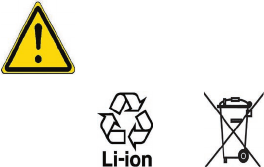
5
WARNING: DANGER OF EXPLOSION IF BATTERY IS INCORRECTLY REPLACED. TO REDUCE RISK
OF FIRE OR BURNS, DO NOT DISASSEMBLE, CRUSH, PUNCTURE, SHORT EXTERNAL CONTACTS,
EXPOSE TO TEMPERATURE ABOVE 140˚F, OR DISPOSE OF IN FIRE OR WATER. REPLACE ONLY WITH
SPECIFIED BATTERIES. RECYCLE OR DISPOSE OF USED BATTERIES ACCORDING TO THE LOCAL
REGULATIONS OR REFERENCE GUIDE SUPPLIED WITH YOUR PRODUCT.
• Take extra precautions
• Keep the battery or device dry and away from water or any liquid as it may cause a short circuit.
• Keep metal objects away so they don’t come in contact with the battery or its connectors as it may
lead to short circuit during operation.
• Do not use a battery that appears damaged, deformed, or discolored, or one that has any rust on its
casing, overheats, or emits a foul odor.
• Always keep the battery out of the reach of babies and small children, to avoid swallowing of the
battery. Consult the doctor immediately if the battery is swallowed.
• If the battery leaks:
• Do not allow the leaking fluid to come in contact with skin or clothing. If already in contact, flush
the affected area immediately with clean water and seek medical advice.
• Do not allow the leaking fluid to come in contact with eyes. If already in contact, DO NOT rub; rinse
with clean water immediately and seek medical advice.
• Take extra precautions to keep a leaking battery away from fire as there is a danger of ignition or
explosion.
• Communicate the appropriate steps immediately in case a hazard occurs.

6
SAFETY PRECAUTIONS FOR DIRECT SUNLIGHT
Keep this product away from excessive moisture and extreme temperatures. Do not leave the product or its
battery inside a vehicle or in places where the temperature may exceed 140°F, such as on a car dashboard,
window sill, or behind a glass that is exposed to direct sunlight or strong ultraviolet light for extended periods of
time. This may damage the product, overheat the battery, or pose a risk to the vehicle.
PREVENTION OF HEARING LOSS
CAUTION: Permanent hearing loss may occur if earphones or headphones are used at
high volume for prolonged periods of time.
SAFETY IN AIRCRAFT
Due to the possible interference caused by this product to an aircraft’s navigation system and its communications
network, using this device’s phone function on board an airplane is against the law in most countries. If you want
to use this device when on board an aircraft, remember to turn off the phone by switching to Flight Mode.
ENVIRONMENTAL RESTRICTIONS
Do not use this product in gas stations, fuel depots, chemical plants or where blasting operations are in progress,
or in potentially explosive atmospheres such as fuelling areas, fuel storehouses, below deck on boats, fuel or
chemical transfer or storage facilities, and areas where the air contains chemicals or particles, such as grain, dust,
or metal powders. Please be aware that sparks in such areas could cause an explosion or fire resulting in bodily
injury or even death.
EXPLOSIVE ATMOSPHERES
When in any area with a potentially explosive atmosphere or where flammable materials exist, the product
should be turned off and the user should obey all signs and instructions. Sparks in such areas could cause an
explosion or fire resulting in bodily injury or even death. Users are advised not to use the equipment at refueling
points such as service or gas stations, and are reminded of the need to observe restrictions on the use of radio
equipment in fuel depots, chemical plants, or where blasting operations are in progress. Areas with a potentially
explosive atmosphere are often, but not always, clearly marked. These include fueling areas, below deck on
boats, fuel or chemical transfer or storage facilities, and areas where the air contains chemicals or particles, such
as grain, dust, or metal powders.
7
ROAD SAFETY
In some states or local jurisdictions, vehicle drivers in motion are not permitted to use telephony services with
handheld devices, except in the case of emergency. In some countries outside the US, using hands-free devices
as an alternative is allowed.
SAFETY PRECAUTIONS FOR RF EXPOSURE
• Avoid using your device near metal structures (for example, the steel frame of a building).
• Avoid using your device near strong electromagnetic sources, such as microwave ovens, sound speakers,
TV and radio.
• Use only original manufacturer-approved accessories, or accessories that do not contain any metal.
• Use of non-original manufacturer-approved accessories may violate your local RF exposure guidelines and
should be avoided.
INTERFERENCE WITH MEDICAL EQUIPMENT
This product may cause medical equipment to malfunction. The use of this device is forbidden in most hospitals
and medical clinics.
If you use any other personal medical device, consult the manufacturer of your device to determine if it
is adequately shielded from external RF energy. Your physician may be able to assist you in obtaining this
information.
Turn the phone OFF in health care facilities when any regulations posted in these areas instruct you to do so.
Hospitals or health care facilities may be using equipment that could be sensitive to external RF energy.
HEARING AIDS
Some digital wireless phones may interfere with some hearing aids. In the event of such interference, you may
want to consult your service provider, or call the customer service line to discuss alternatives.
NONIONIZING RADIATION
Your device has an internal antenna. This product should be operated in its normal-use position to ensure the
radiative performance and safety of the interference. As with other mobile radio transmitting equipment, users
are advised that for satisfactory operation of the equipment and for the safety of personnel, it is recommended
that no part of the human body be allowed to come too close to the antenna during operation of the equipment.
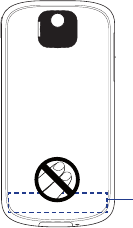
8
Use only the supplied integral antenna. Use of unauthorized or modified antennas may impair call quality and
damage the phone, causing loss of performance and SAR levels exceeding the recommended limits as well as
result in non-compliance with local regulatory requirements in your country.
To assure optimal phone performance and ensure human
exposure to RF energy is within the guidelines set forth in
the relevant standards, always use your device only in its
normal-use position. Do not touch or hold the antenna
area unnecessarily when placing or receiving a phone call.
Contact with the antenna area may impair call quality and
cause your device to operate at a higher power level than
needed. Avoiding contact with the antenna area when the
phone is IN USE optimizes the antenna performance and
the battery life.
Internal
antenna
location
General Precautions
• Heed service markings
Except as explained elsewhere in the Operating or Service documentation, do not service any product
yourself. Any necessary services on components inside these compartments should be done by an
authorized service technician or provider.
• Damage requiring service
Unplug the product from any electrical power source and refer servicing to an authorized service
technician or provider under the following conditions:
• Liquid has been spilled or an object has fallen into the product.
• The product has been exposed to rain or water.
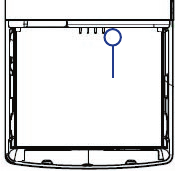
9
The LDI (Liquid Damage Indicator) is a circular label
that changes color, from white to red, when the phone’s
sensitive area (e.g. battery contacts) is exposed to water.
LDI
• The product has been dropped or damaged.
• There are noticeable signs of overheating.
• The product does not operate normally when you follow the operating instructions.
• Avoid hot areas
The product should be placed away from heat sources such as radiators, heat registers, stoves, or other
products (including, but limited to, amplifiers) that produce heat.
• Avoid wet areas
Never use the product in a wet location.
• Avoid using your device after a dramatic change in temperature
When you move your device between environments with very different temperature and/or humidity
ranges, condensation may form on or within the device. To avoid damaging the device, allow sufficient
time for the moisture to evaporate before using the device.
NOTE: When taking the device from low-temperature conditions into a warmer environment or from
high-temperature conditions into a cooler environment, allow the device to acclimate to room
temperature before turning on the power.
• Avoid pushing objects into product
Never push objects of any kind into cabinet slots or other openings in the product. Slots and openings are
provided for ventilation. These openings must not be blocked or covered.
10
• Mounting Accessories
Do not use the product on an unstable table, cart, stand, tripod, or bracket. Any mounting of the product
should follow the manufacturer’s instructions, and should use a mounting accessory recommended by the
manufacturer.
• Avoid unstable mounting
Do not mount or place the product on an unstable base.
• Use product with approved equipment
This product should be used only with personal computers and/or options identified as suitable for use
with your equipment.
• Adjust the volume
Turn down the volume before using headphones or other audio devices.
• Cleaning
Unplug the product from the wall outlet before cleaning. Do not use liquid cleaners or aerosol cleaners.
Use a damp cloth for cleaning, but NEVER use water to clean the LCD screen.
11
Contents
Welcome to T-Mobile 21
Introduction ................................................................................................................................................ 22
T-Mobile Services and Applications ................................................................................................... 23
Voice/Phone ............................................................................................................................ 23
Voicemail .................................................................................................................................. 24
E-mail ......................................................................................................................................... 24
Messaging services ............................................................................................................... 24
T-Mobile® myFavesSM .............................................................................................................. 25
T-Mobile HotSpot .................................................................................................................. 26
T-Mobile Address Book ....................................................................................................... 26
International Service ............................................................................................................ 26
Activating Service ..................................................................................................................................... 27
Chapter 1 Getting Started 29
1.1 Getting to Know Your Phone and Its Accessories ............................................................... 30
1.2 Inserting the SIM Card .................................................................................................................. 36
1.3 Installing a microSD Card ............................................................................................................ 38
1.4 Charging the Battery ..................................................................................................................... 39
1.5 Turning On the Phone .................................................................................................................. 39
1.6 The Home Screen ........................................................................................................................... 40
Shortcut Bar ............................................................................................................................ 41
1.7 Programs On Your Phone ............................................................................................................ 45
12
1.8 Using the Start Menu .................................................................................................................... 50
1.9 Using the Quick List ....................................................................................................................... 50
1.10 Entering Information ..................................................................................................................... 51
Input modes ............................................................................................................................ 51
The 20-key QWERTY keyboard ......................................................................................... 52
Multipress mode .................................................................................................................... 53
T9 mode ................................................................................................................................... 54
Numeric mode ....................................................................................................................... 56
1.11 Battery Information ....................................................................................................................... 56
1.12 Shortcut Key ..................................................................................................................................... 58
1.13 Status Indicators ............................................................................................................................. 58
Chapter 2 Using Phone Features 61
2.1 Using the Phone ................................................................................................................................ 62
The Phone screen .................................................................................................................. 62
Set ring tones .......................................................................................................................... 62
2.2 Making a Call ...................................................................................................................................... 63
Make a call from the Home screen ................................................................................. 63
Make a call from Contacts .................................................................................................. 64
Make a call from Call History ............................................................................................. 64
Make a call from Speed Dial .............................................................................................. 65
Make a call from SIM Manager ......................................................................................... 65
2.3 Receiving a Call .................................................................................................................................. 66
2.4 In-Call Options ................................................................................................................................... 67
2.5 Additional Dialing Information .................................................................................................... 69
13
Make an emergency call ..................................................................................................... 69
Make an international call .................................................................................................. 69
Insert a pause or long pause in a dialing sequence ................................................. 69
Chapter 3 Synchronizing Information with Your Computer 71
3.1 About Synchronization ................................................................................................................... 72
Ways to synchronize ............................................................................................................. 72
3.2 Setting Up Windows Mobile® Device Center on Windows Vista ...................................... 73
Set up synchronization in Windows Mobile® Device Center ................................. 73
3.3 Setting Up ActiveSync® on Windows XP ................................................................................... 75
Install ActiveSync® ................................................................................................................ 75
Set up synchronization in ActiveSync® ......................................................................... 75
3.4 Synchronizing With Your Computer ........................................................................................... 76
Start and stop synchronization ........................................................................................ 76
Change which information is synchronized ................................................................ 77
Troubleshoot sync connection problems .................................................................... 78
3.5 Synchronizing via Bluetooth ......................................................................................................... 78
3.6 Synchronizing Music and Video ................................................................................................... 79
Chapter 4 Managing your Phone 81
4.1 Personalizing Your Phone .............................................................................................................. 82
Set up the Home screen .................................................................................................... 82
Set date, time, language, and other regional options ............................................. 83
Choose how to be notified about events or actions ................................................ 83
Set personal information .................................................................................................... 85
Set performance and maintenance options ............................................................... 86
14
4.2 Adding and Removing Programs ................................................................................................ 87
4.3 Using Task Manager and Managing Memory ......................................................................... 88
4.4 Managing and Backing Up Files .................................................................................................. 88
Copy files using Windows Mobile® Device Center/ActiveSync® to the PC ....... 89
Use File Explorer .................................................................................................................... 89
4.5 Protecting Your Phone .................................................................................................................... 91
4.6 Restarting Your Phone ..................................................................................................................... 94
4.7 Resetting Your Phone ...................................................................................................................... 94
Chapter 5 Organizing Phone Information 95
5.1 Contacts ............................................................................................................................................ 96
Create a contact on your phone ...................................................................................... 96
Edit and call a contact ......................................................................................................... 97
Find a contact ......................................................................................................................... 97
Share contact information ................................................................................................. 98
5.2 SIM Manager .................................................................................................................................... 99
5.3 T-Mobile® myFavesSM ...................................................................................................................... 101
T-Mobile® myFavesSM on the Home screen ................................................................101
Add myFaves contacts .......................................................................................................102
Rotate and crop a photo ..................................................................................................103
Call a myFaves contact ......................................................................................................104
myFaves settings .................................................................................................................104
Edit a myFaves contact ......................................................................................................105
15
5.4 Calendar ...........................................................................................................................................106
Create a personal appointment .....................................................................................106
View your appointments ..................................................................................................107
Send appointments ............................................................................................................108
5.5 Tasks ..................................................................................................................................................109
5.6 T-Mobile Address Book ..............................................................................................................110
5.7 Voice Recorder ...............................................................................................................................111
Chapter 6 Exchanging Messages 113
6.1 Messaging .......................................................................................................................................114
6.2 Text Messages ................................................................................................................................115
Compose and send text messages ...............................................................................115
Receive text messages ......................................................................................................116
6.3 Picture Messages ..........................................................................................................................116
Create and send Picture Messages ...............................................................................117
View, reply to and block Picture Messages ................................................................118
6.4 Audio Postcards ............................................................................................................................119
6.5 Use Instant Messaging ...............................................................................................................121
AIM® .........................................................................................................................................121
ICQ® ..........................................................................................................................................122
Yahoo!® ....................................................................................................................................124
Windows Live™ Messenger ..............................................................................................125
6.6 Set Up E-Mail ..................................................................................................................................126
16
6.7 Use E-mail ........................................................................................................................................128
Create and reply to e-mails ..............................................................................................128
Filter the Inbox message list ............................................................................................129
Send and download e-mails ...........................................................................................131
Customize e-mail settings ................................................................................................132
6.8 Use Keyboard Shortcuts ............................................................................................................134
Chapter 7 Working with Company E-mails and Meeting Appointments 135
7.1 Synchronizing Your Phone with the Exchange Server ......................................................136
Set up an Exchange Server connection from your phone ...................................136
Set up an Exchange Server connection from your PC ...........................................138
Start synchronization .........................................................................................................142
7.2 Working with Company E-mails .................................................................................................143
Automatic synchronization through Direct Push ....................................................143
Scheduled synchronization .............................................................................................145
Instant download through Fetch Mail .........................................................................145
Search for e-mails on the Exchange Server ...............................................................146
Flag your messages ............................................................................................................147
Out-of-office auto-reply ....................................................................................................148
View a document linked to an e-mail message .......................................................148
7.3 Managing Meeting Requests ......................................................................................................149
7.4 Finding Contacts in the Company Directory ........................................................................151
7.5 E-mail Security .................................................................................................................................153
Encrypt and sign messages .............................................................................................153
Set permissions on an e-mail message .......................................................................156
17
Chapter 8 Getting Connected 157
8.1 Comm Manager ...............................................................................................................................158
8.2 Ways of Connecting to the Internet .........................................................................................159
8.3 Wi-Fi ....................................................................................................................................................160
Connect to T-Mobile HotSpot .........................................................................................160
Connect to other wireless networks ............................................................................164
8.4 GPRS/EDGE .......................................................................................................................................166
8.5 Dial-up and Others .........................................................................................................................167
8.6 Internet Explorer® Mobile ............................................................................................................168
Browse the Web ...................................................................................................................169
8.7 Using Your Phone as a Modem (Internet Sharing) ..............................................................171
8.8 Bluetooth ...........................................................................................................................................173
Bluetooth modes .................................................................................................................173
Bluetooth partnerships .....................................................................................................174
Connect a Bluetooth hands-free or stereo headset ...............................................176
Beam information using Bluetooth ..............................................................................178
Print files via Bluetooth .....................................................................................................179
8.9 Windows LiveTM ................................................................................................................................... 181
Set up Windows LiveTM ......................................................................................................... 181
The Windows LiveTM interface .........................................................................................183
18
8.10 Windows Live™ Messenger .......................................................................................................184
Launch the messenger and sign in ...............................................................................184
Add Windows LiveTM contacts .........................................................................................185
Send instant messages ......................................................................................................186
Personalize the messenger ..............................................................................................188
8.11 Windows LiveTM Search ...............................................................................................................189
Chapter 9 Experiencing Multimedia 191
9.1 Camera ................................................................................................................................................192
Take a photo or capture a video clip ............................................................................192
Capture modes .....................................................................................................................192
Camera mode icons and indicators ..............................................................................194
Quick Settings Menu ..........................................................................................................195
Use zooming .........................................................................................................................196
Quick Send .............................................................................................................................196
The Review screen ..............................................................................................................198
Camera Capture and Advanced Settings ...................................................................199
9.2 Pictures & Videos .............................................................................................................................200
Copy pictures, animated GIFs and video clips ..........................................................200
View media files ...................................................................................................................200
Pictures & Videos menu ....................................................................................................201
Send photos to your Windows Live™ Space ..............................................................202
9.3 Windows Media® Player Mobile .................................................................................................204
About the controls ..............................................................................................................204
About the screens and menus .......................................................................................205
19
About licenses and protected files ...............................................................................206
Synchronize video and audio files ................................................................................206
Play media .............................................................................................................................210
Playlists ...................................................................................................................................210
Troubleshooting ..................................................................................................................211
9.4 Java Applications ............................................................................................................................212
Install and run MIDlets/MIDlet suite .............................................................................212
Manage MIDlets ..................................................................................................................214
Chapter 10 Using Other Applications 217
10.1 Microsoft® Office Mobile ............................................................................................................218
10.2 Microsoft® Office Word Mobile ................................................................................................218
View documents ..................................................................................................................218
Edit and send documents ................................................................................................219
10.3 Microsoft® Office Excel® Mobile ..............................................................................................220
View worksheets ..................................................................................................................220
Edit and send worksheets ................................................................................................222
10.4 Microsoft® Office PowerPoint® Mobile ..................................................................................224
10.5 Microsoft® Office OneNote® Mobile ......................................................................................226
10.6 Adobe® Reader® LE ......................................................................................................................227
10.7 Speed Dial .......................................................................................................................................228
10.8 Voice Command ............................................................................................................................229
20
10.9 RSS Hub ...........................................................................................................................................232
Subscribe to and organize news channels ................................................................232
View and organize headlines ..........................................................................................235
View the news summary ..................................................................................................236
Configure RSS Hub .............................................................................................................239
Appendix 243
A.1 Specifications .................................................................................................................................244
A.2 Regulatory Notices ......................................................................................................................247
Index 253
Welcome to T-Mobile
Introduction
T-Mobile Services and Applications
Activating Service
22 Welcome to T-Mobile
Introduction
This User Manual provides you with detailed instructions on using your T-Mobile ShadowTM and
services.
You will also find information from the following sources:
Windows Mobile® Web site
(http://www.microsoft.com/windowsmobile)
T-Mobile Customer Care
The T-Mobile Customer Care team offers responsive, knowledgeable customer support 24 hours a
day, seven days a week. In addition, you can always access free online help for your device at www.
support.t-mobile.com, and for your account at www.my.t-mobile.com.
• General Questions
Our Customer Care team can assist in many things including service activation, billing, GSM/
GPRS coverage information, voicemail, and feature additions. Just dial 1-800-937-8997 or 611
on your device.
Welcome to T-Mobile 23
T-Mobile Services and Applications
With your new T-Mobile (NAME) and T-Mobile’s service package, you get the freedom of excellent
voice and broadband connectivity in many locations nationwide.
Important By using T-Mobile services, you acknowledge that you have read, understood and agreed to be
bound by each of the terms and conditions of the Service Agreement.
When you activate service with T-Mobile, the following features and services are available to you:
Voice/Phone
• Local calling and nationwide long distance calling
• International calling *
• Caller ID
• Call waiting and call hold **
• Conference calling **
• Call forwarding **
* Note Log on to www.my.t-mobile.com to set up international calling.
See www.tmobile.com/international/ for rate and other information on international services.
** Notes • Airtime rates apply for all completed calls. Calls that are forwarded to numbers outside the local
calling area are charged long distance rates. These features may include charges for multiple calls.
• Calls made in any T-Mobile coverage area, including 911 calls, may not always be completed due to
factors such as weather conditions, terrain, foliage, building structures, and equipment limitations.
• You can use your device to access 911 Emergency Service while you are on a call. You can access 911
even if you DO NOT have a SIM card in the device. All 911 calls are FREE.

24 Welcome to T-Mobile
Voicemail
Your T-Mobile (NAME) has been programmed to forward calls when your line is busy or when
you are not available. T-Mobile’s voicemail system offers your caller the option to record a voice
message that you can play back at your convenience or to send a numeric page to your device.
Note Airtime charges apply to receipt and retrieval of voicemail messages.
E-mail
Set Up E-mail ( ) provides you unlimited access to your work and personal email. Instantly
access your e-mail from AOL®, Yahoo!® , EarthLink™, Comcast®, Microsoft® Exchange and many
more, including any POP3 or IMAP4 e-mail server.
For more information about setting up and using e-mail, see Chapter 6 and 7.
Messaging services
Text Messaging (SMS)
Text messaging allows you to send, receive, and reply to short text messages using your device.
Messages may be sent to and from mobile devices that support text messaging. You may be
charged for using text messaging depending on your rate plan. Visit www.t-mobile.com or a
T-Mobile store for domestic and international text messaging rates.
For more information about sending text messages, see Chapter 6.
Multimedia Messaging (MMS)
Picture Messaging allows you to send and receive picture messages. You can take pictures and
videos using the device’s integrated camera and send them to family and friends. You may be
charged for using Picture Messaging depending on your rate plan. Visit www.t-mobile.com or a
T-Mobile store for domestic and international Picture Messaging rates, and information on phones
and participating services capable of receiving Picture Messages.
For more information about sending Picture Messages, see Chapter 6.
Welcome to T-Mobile 25
Instant Messaging (IM)
Your device comes with instant messaging (IM) applications pre-installed for your convenience.
Your normal screen name and password work just as they would on any computer connected to
the Internet. You may be charged for using instant messaging depending on your rate plan.
Visit www.t-mobile.com or a T-Mobile store for domestic and international instant messaging
rates.
For more information about using Instant Messaging, see Chapter 6.
T-Mobile® myFavesSM
T-Mobile® myFavesSM helps you stay connected to the people who matter most in your life.
Simply choose any five U.S. phone numbers* you call most often, on any network, and have them
displayed on your phone’s main screen. To subscribe, go to www.t-mobile.com.
When you subscribe to the service, you can take advantage of the following:
• Unlimited nationwide calling to any five numbers, on any network (even landlines)
• One-touch calling, text messaging**, and photo sharing**
• No domestic roaming or domestic long-distance charges
• Personalize contacts with favorite pictures** or downloadable icons**
* Excluding 411, voicemail, toll-free, 900, calling card, customers’ own numbers, numbers accessing 500 or more
lines - other restrictions may apply.
** Separate purchase/download charges may apply. Separate charges apply to send/receive domestic/
international text and picture messages.
For more information, see “T-Mobile® myFavesSM” in Chapter 5.
You can also visit www.t-mobile.com for the latest information.
26 Welcome to T-Mobile
T-Mobile HotSpot
T-Mobile HotSpot gives you wireless access to the Internet over the T-Mobile Wi-Fi network in
locations across the U.S., such as airports, coffeehouses, bookstores, universities, and more.
To access T-Mobile HotSpot, you must add a data plan to your account. Inform your T-Mobile
Activations representative that you want to add a data plan when activating your T-Mobile service.
Visit www.t-mobile.com or a T-Mobile store for plan information.
For more information about T-Mobile HotSpot, see “Connect to T-Mobile HotSpot” in Chapter 8.
T-Mobile Address Book
This is a free service that lets you view, back up, and manage your contact, tasks, and calendar
items on www.t-mobile.com. See Chapter 5 for details.
International Service
You can access the Internet and make calls using your device while abroad. To take advantage of
this service, visit www.my.t-mobile.com or contact Customer Care at 1-800-937-8997 to activate
international calling features. Inform the representative that you want to use T-Mobile service
(voice and data) internationally. The representative will add the service to your account at no
charge. For more information on international service, visit www.t-mobile.com/international/.
Note Additional fees may apply. Countries that support international wireless Internet roaming may not be
the same as countries that support international voice roaming.
Please refer to www.t-mobile.com/international/ for information on world-class Internet service.
Welcome to T-Mobile 27
Activating Service
If your service has not been activated, then follow the steps in this section to activate. The
T-Mobile Activations representative will set up your service and assign your mobile number. It takes
about 20 minutes to activate voice service and may take up to 24 hours to activate data service.
Business and government accounts may take additional time to activate voice and data service. By
activating service, you acknowledge that you have read and agreed to the Terms and Conditions of
the Service Agreement.
1. Have your service agreement and the following information ready for your Activations
representative:
• Name, home address, home phone, preferred billing address
Note For business and government accounts, your Activations representative will also require your
physical address, company name or government agency name, and the tax ID.
• Social Security number, current driver’s license number, and date of birth for credit-check
purposes
• Model number of your device (T-Mobile (NAME))
• SIM serial number (on the back of the SIM card)
• IMEI number (on the label under the battery)
• Agent code (on your service agreement)
• Your choice of T-Mobile rate plans and services
2. Call Customer Care at 1-800-937-8997 from a landline phone.
28 Welcome to T-Mobile

Chapter 1
Getting Started
1.1 Getting to Know Your Phone and Its Accessories
1.2 Inserting the SIM Card
1.3 Installing a microSD Card
1.4 Charging the Battery
1.5 Turning On the Phone
1.6 The Home Screen
1.7 Programs On Your Phone
1.8 Using the Start Menu
1.9 Using the Quick List
1.10 Entering Information
1.11 Battery Information
1.12 Shortcut Key
1.13 Status Indicators
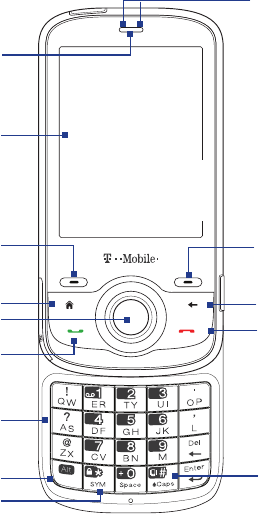
30 Getting Started
1.1 Getting to Know Your Phone and Its Accessories
11
12
1
3
4
5
6
7
9
14
2
13
10
8

Getting Started 31
Item Function
1. Receiver Listen to a phone call.
2.
Display Screen
3. Left SOFT KEY Press to perform the command shown in the label above the button.
4. HOME Press to go to the Home Screen.
5. NAVIGATION
WHEEL/CENTER
SELECT Key
Use to scroll left, right, up, or down. You can either turn the wheel or press the wheel to
scroll through items or screens. Press the center to use as the CENTER SELECT Key.
The NAVIGATION WHEEL also features an LED indicator for certain phone alerts. For more
information, see "Navigation Wheel Alerts" in this chapter.
6. SEND
Press to dial a phone number, answer a call, switch to another call, or put a call on hold. Press
and hold to activate/deactivate speakerphone mode
.
7. 20-key QWERTY
Keyboard
Slide up the front panel of the phone to reveal the keyboard. Use to dial phone numbers,
enter information, and write messages.
8. Alt Key
Press once to type symbols and enter numbers in text fields. Press twice for continuous
symbol or number entries.
9. Symbol Key Press to open the Symbol pad.
10. Caps Key Press to type a single capital letter; press twice to type in all caps.
11. END Press to end a call.
12. BACK Press to go to the previous screen, or backspace over characters.
13.
Right
SOFT KEY Press to perform the command shown in the label above the button.
14. LED Indicators The left LED indicators (green/red/amber) notify you of the battery and network status
of your phone, while the right indicators (blue/green) notify you of Bluetooth and Wi-Fi
connectivity status. For more information, see "LED indicator lights" in this chapter.
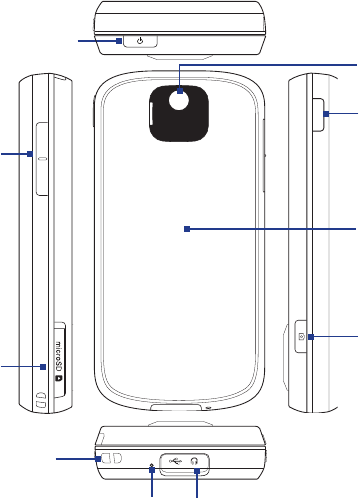
32 Getting Started
20
15
24
21
16
17
18
23
19
22

Getting Started 33
Item Function
15. POWER Press and hold for about 3 seconds to turn the phone on or off.
16. VOLUME CONTROL Adjust the volume of your phone. Press the Up-arrow button to increase the
volume; press the Down-arrow button to decrease the volume.
17. microSD™ card slot
Remove the cover to insert a microSD™ card.
18. Lanyard/Strap Holder
Attach a strap to carry the device.
19. Microphone Speak into the microphone when receiving or making a phone call or during voice
recording.
20. Sync Connector/
Earphone Jack
Use for synchronizing data or recharging the battery. Remove the cover to
connect the earphone to listen to audio media or use the phone’s hands-free kit.
21. CAMERA Press to open the Camera program.
22. Back Cover Remove to insert the battery and SIM card.
23. SHORTCUT KEY Press or press and hold to open phone applications. By default, briefly pressing
this button calls up the Messaging screen; pressing and holding this button
activates Voice Command. See "Shortcut Key" in this chapter for more details.
24. Camera Lens
Navigation Wheel Light Alerts
Phone Alert Light Behavior
Phone ringing The light flashes on with 3 quick pulses and then fades off.
New E-mail Breathing (the light cycles between fading on and fading off).
New Text Message Long Flashing (the light flashes on every three seconds, repeating three times).
New Voice Message Short Flashing (the light flashes on every second, repeating three times).
Power On The light slowly fades on and then slowly fades off.

34 Getting Started
LED indicator lights
Various colors that might display in the two LED Indicators are summarized here.
Left LED Status
Solid green Battery is fully charged.
Blank Battery case is empty, no SIM card inserted or phone is off.
Solid amber Battery is charging or the phone is using ActiveSync to synchronize with a PC.
Solid red Battery is not installed or battery is over-discharged.
Flashing green Connected to the network.
Flashing red Battery very low (less than 10%).
Flashing amber Battery temperature is hotter or colder than the functional limits of 32 to 118 degrees
Fahrenheit, and has stopped charging.
Amber/Green LED off Battery fault. The “Battery Fault” indicator ( ) is displayed. In this case, the flashing
green LED can be recovered by unplugging the AC adapter.
Right LED Status
Flashing blue Bluetooth mode set to “On” or “Visible” mode.
Flashing green Wi-Fi is turned on.
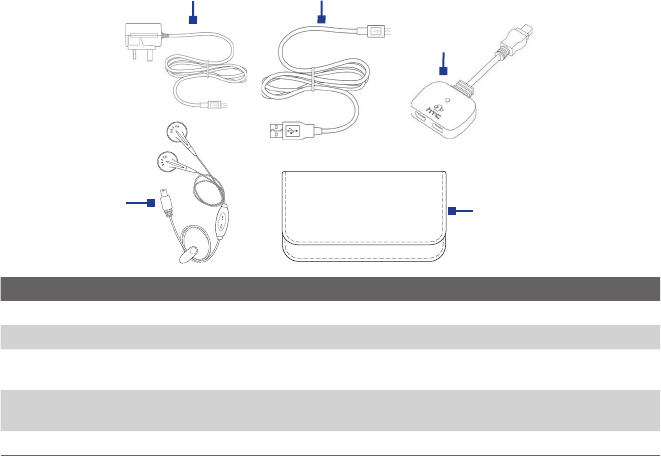
Getting Started 35
Accessories
The following accessories are provided with the T-Mobile (NAME):
4
1
5
2
3
Accessory Function
1. AC adapter Recharges the phone battery.
2. USB cable Connects your phone to a PC to synchronize data and/or to charge the phone.
3.
Audio / Charging cable
Allows the use of a travel charger / AC adapter while you're using a stereo
headset with your phone.
4.
Stereo headset
You can press the button to pick up a call or put a call on hold or press and hold
the button to end the call. Plug into the Earphone Jack to listen to audio files.
5. Pouch
Acts as a protective carrying case for your phone.

36 Getting Started
1.2 Inserting the SIM Card
Your SIM (Subscriber Identity Module) card is given to you by T-Mobile and contains your basic
subscriber information, such as your phone number and your address book.
Before you begin, ensure that the phone is turned off.
Open the cover and remove the battery
1. Hold the phone in one hand facing down in the palm of your hand, and then with your other
hand, slide the back cover upward to remove it.
2. Remove the battery by lifting the black strip from the bottom end.
Black strip
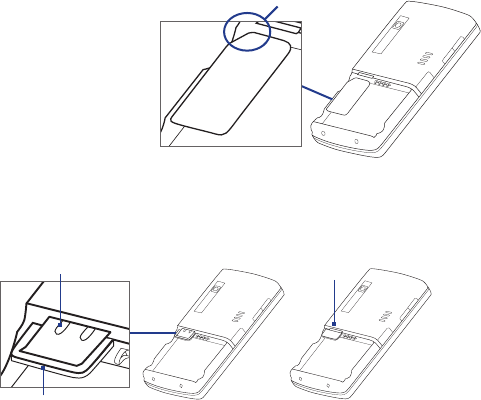
Getting Started 37
Insert the SIM card
Insert the SIM card into the slot at the top-right corner (underneath the metal tab) with its gold-
plated contacts facing down. Push the SIM card all the way in until the SIM card locks into place.
After inserting the SIM card, push the metal tab upwards. Make sure that it is fully pushed in.
Cut-off corner of
SIM card
Remove the SIM card
1. Pull down the metal tab (the SIM card will slide down along with metal tab).
2. Push up the metal tab and then slide out the SIM card.
Metal tab
SIM card
Push up the
metal tab
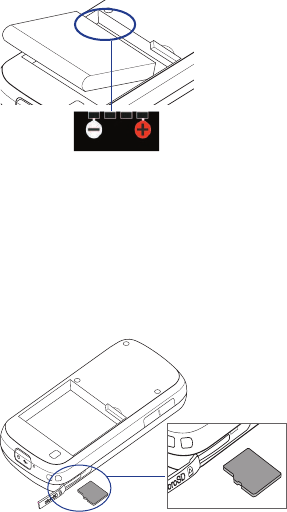
38 Getting Started
Replace the battery
Make sure the metal tab is pushed in all the way before inserting the battery.
1. Align the exposed metal contacts on the
edge of the battery with the prongs in the
body of the phone then gently push the top
of the battery into place.
2. Press the bottom part of the battery into
place.
1.3 Installing a microSD Card
You can install a microSD™ (Secure Digital) card on your phone to have an alternative storage place
for your images, video, music, and other phone data.
Note microSD card is not shipped with the phone.
To install the microSD card
1. Remove the cover on the right side of the
phone.
2. Insert the microSD card into the slot with its
gold contacts facing up.
To remove, press the microSD card to pop it
out of the slot.
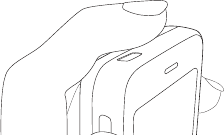
Getting Started 39
1.4 Charging the Battery
You can charge the battery by using either the AC adapter or the USB cable that came in the box.
Note You should only use the AC adapter and USB cable that came in the box to charge the battery of the
phone.
Use the AC adapter
1. Plug the AC adapter plug in to an electrical outlet.
2. Insert the USB end of the AC adapter to the sync connector port at the bottom of the phone.
The battery is fully charged after about 3 hours.
Use the USB cable
1. Insert the big USB plug end to a USB port on your computer.
2. Insert the small USB plug end to the sync connector port at the bottom of the phone.
Tip When connecting the AC adapter or the USB cable to the phone, make sure that you push the end of
the cable that connects to the phone all the way in.
1.5 Turning On the Phone
Turn on the phone by pressing the
POWER
button on top of the phone for
about 3
seconds.
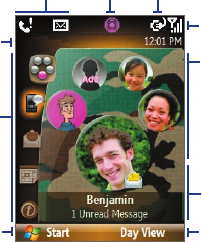
40 Getting Started
1.6 The Home Screen
The Home screen displays important information, such as upcoming appointments, status
indicators, current date and time, battery level, and profile.
The Home screen also gives you quick access to various applications and settings that you
frequently use on your phone. Press NAVIGATION WHEEL up/down to go through the icons
on the Shortcut Bar (left panel) of the screen. When an icon is selected, you can then scroll the
NAVIGATION WHEEL clockwise/counterclockwise or press NAVIGATION WHEEL left/right to go
through the available items of that particular Shortcut Bar icon. Open the item or application by
pressing CENTER SELECT.
Tip To access the Home screen from anywhere, press the HOME key on the phone.
Home Screen
1
7
4 65
8
10
2
9
3
1. Select to display all program icons.
2. Shortcut Bar. See "Shortcut Bar" in this chapter for details.
3. Displays the network carrier name the phone is using and the
time.
4. Displays notifications, such as missed calls or new messages.
5. Displays the T-Mobile HotSpot status. See Chapter 8 for details.
6. Displays the power status.
7. Displays the network signal strength.
8. Depending on the Shortcut Bar icon selected, this displays
the wallpaper image, an image of an item associated with the
Shortcut Bar icon, T-Mobile® myFavesSM contacts, or photos in
your phone.
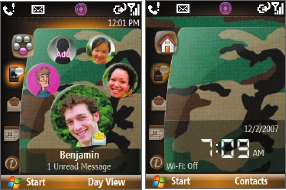
Getting Started 41
9. Depending on the Shortcut Bar icon selected, this displays the myFaves contact name, names of the
item associated with the Shortcut Bar icon, messages, notifications, appointments, or music track name.
10. Select to open the program, setting, or shortcut associated with the selected Shortcut Bar item.
Shortcut Bar
The Shortcut Bar lets you quickly access various information and applications on your phone.
myFavesSM
Access your myFavesSM contacts right on the
Home screen. See Chapter 5 for details.
Pressing the HOME key while anywhere on the
Home screen will bring you to your myFaves.
If you do not subscribe to the myFaves service, a
different screen appears.
with myFaves without myFaves
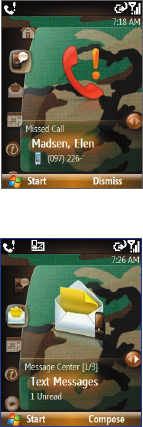
42 Getting Started
Notifications
Gives you quick access to view missed calls and new messages.
This icon glows when there is a new notification.
Scroll the NAVIGATION WHEEL clockwise or counterclockwise
to go through items and then press CENTER SELECT to open a
specific notification.
Message Center
Gives you quick access to all of your configured messaging
account inboxes. You can also create and send an audio
postcard and create a new e-mail account here.
To quickly create a new message or audio postcard, scroll to
the messaging account or Audio Postcards and then select
Compose.

Getting Started 43
Appointments
Lets you see your upcoming appointments for the day or set
a new appointment. If you have more than one appointment
for the day, use the NAVIGATION WHEEL to scroll through the
appointments.
Internet
Quickly open your browser to surf the Internet or access t-zones
to purchase ring tones and wallpapers. You can also access your
T-Mobile account here.
You can quickly go to the t-zones page to purchase wallpapers
or ringtones by selecting Browse Wallpaper or Browse Hi-Fi
Ringers.
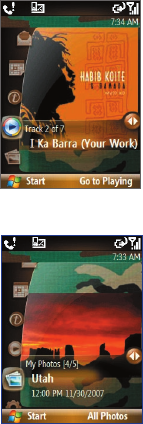
44 Getting Started
Media
Start your music player straight from the Home screen. Use the
NAVIGATION WHEEL to scroll through the music in your phone
and then press CENTER SELECT to play and pause music.
While playing back a song, select Full Screen to open Windows
Media Player to display more playback controls.
Photos
Browse the photos in your phone by using the NAVIGATION
WHEEL. Press CENTER SELECT to view a photo using the picture
viewer.
While viewing the photo, you can quickly send the image using
any one of your messaging accounts.
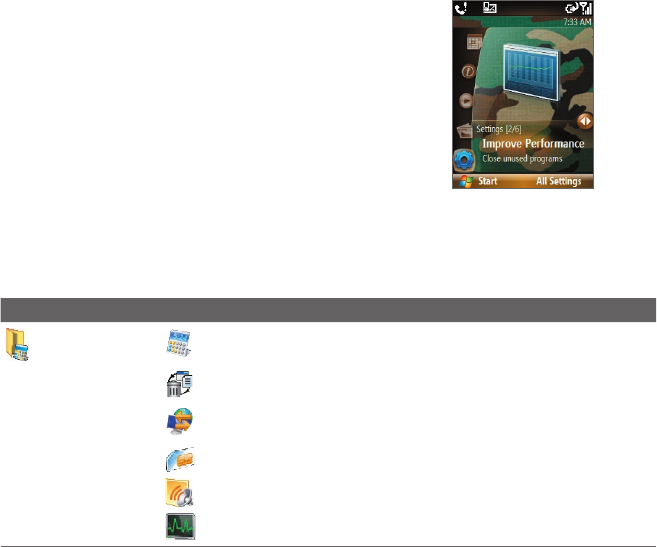
Getting Started 45
Settings
Lets you quickly access the Comm Manager and Task Manager,
change your profile, wallpaper, or ring tone, and check the
phone’s battery power.
Select All Settings to show all available settings.
1.7 Programs On Your Phone
The following table lists icons of the programs that are already installed on your phone or are
available on the Getting Started Disc that came with your phone.
Icon Program Description
Accessories Calculator Do basic arithmetic and calculations.
Clear Storage Clear the memory and restore the phone back to factory
default settings.
Internet Sharing Turn your phone into an external modem for your
computer.
SIM Manager Manage the contacts that are stored on your SIM card.
Voice Recorder Create short voice recordings.
Task Manager Close running programs and check available memory on
your phone.
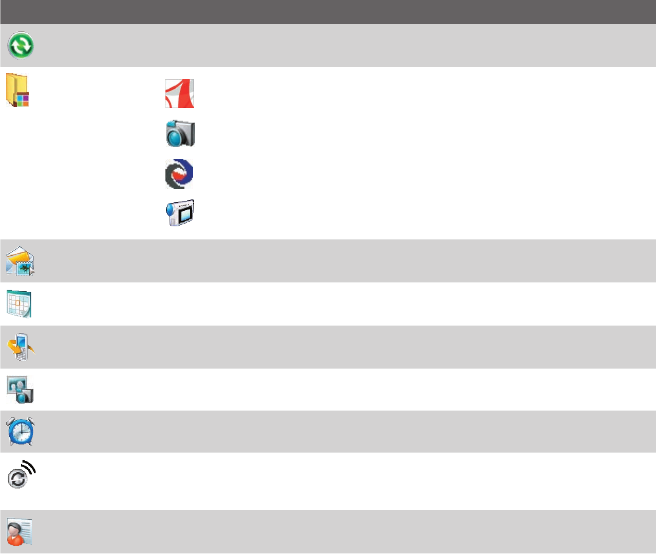
46 Getting Started
Icon Program Description
ActiveSync Synchronize information between your phone and PC.
Applications Adobe Reader LE View PDF files.
Camera Capture photos in various modes.
Java Applications Download and install Java-based applications, such as
games and tools.
Video Recorder Capture video clips in various modes and duration.
Audio
Postcards
Quickly add a voice recording to captured photos and then send them to family and
friends.
Calendar Keep track of your appointments, and create meeting requests.
Call History Keep track of all phone calls made, received, and missed.
Camera
Album
View photos that you captured using the phone’s camera.
Clock &
Alarm
Set the date and time and alarms.
Comm
Manager
Manage your phone's connections (including Wi-Fi, GPRS/EDGE, Bluetooth, and
ActiveSync), turn the phone on or off, enable or disable the Direct Push function,
and more.
Contacts Keep track of contact information.
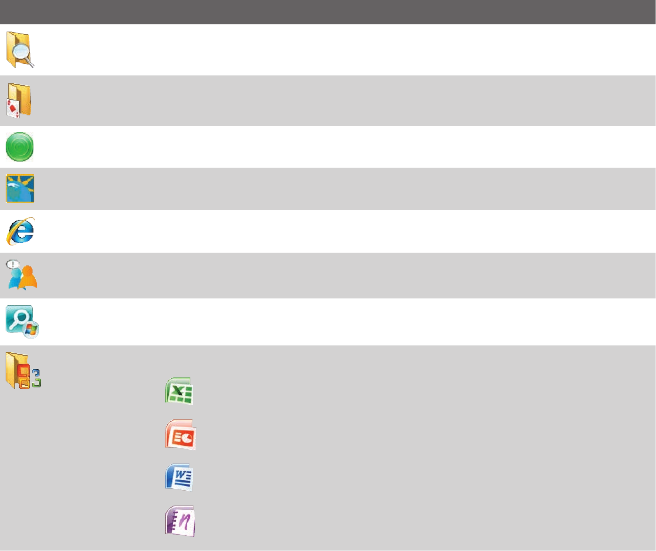
Getting Started 47
Icon Program Description
File Explorer Organize and manage files and folders.
Games Play two games, Bubble Breaker and Solitaire, that come with your phone.
Getting
Started
Learn how to use some of the features of Windows Mobile such as setting the date
and time, setting up e-mail, setting up a Bluetooth headset, and more.
Handango
InHand
Browse, purchase, and install applications for your phone.
Internet
Explorer
Browse Web and WAP sites as well as download new programs and files from the
Internet.
Instant
Messaging
Access various instant messaging programs such as AOL®, ICQ® and Yahoo®.
Live Search Search for locations that suit your interests, plan a driving route, check map, and see
traffic conditions.
Office Mobile Use the complete suite of Microsoft® Office applications for your phone.
Excel Mobile View and edit Microsoft® Excel® worksheets.
PowerPoint Mobile View Microsoft® PowerPoint® presentation files.
Word Mobile View and edit Microsoft® Word documents and text files.
OneNote Mobile Create OneNote files on your phone and then
synchronize them with your PC.
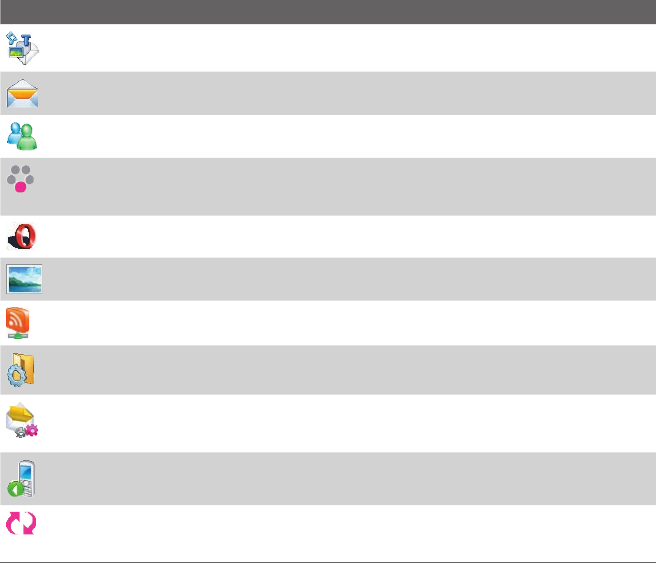
48 Getting Started
Icon Program Description
Message
Options
Set Picture Message preferences and settings.
Messaging Send and receive e-mails, text messages, and picture messages.
Messenger Use this mobile version of Windows Live Messenger.
myFaves Use T-Mobile® myFavesSM to stay connected to the people who matter most in your
life. Simply choose any five U.S. phone numbers you call most often, on any network,
and have them displayed on your phone’s Home screen.
Opera
Browser
Browse the Web using Opera's Internet browser.
Pictures &
Videos
View and manage pictures, animated GIFs, and video files on your phone or a
storage card.
RSS Hub RSS reader that lets you download the latest news headlines from the Internet.
Settings Personalize your phone to suit the way you use it.
Set Up
E-Mail
Enjoy unlimited access to your work and personal email. Instantly access your e-mail
from AOL®, Yahoo!® , EarthLink™, Comcast®, Microsoft® Exchange and many more,
including any POP3 or IMAP4 e-mail server.
Speed Dial Create speed dial entries for dialing frequently called phone numbers or for opening
frequently accessed programs.
T-Mobile
Address
Book
Synchronize and back up contacts with the T-Mobile Web site.
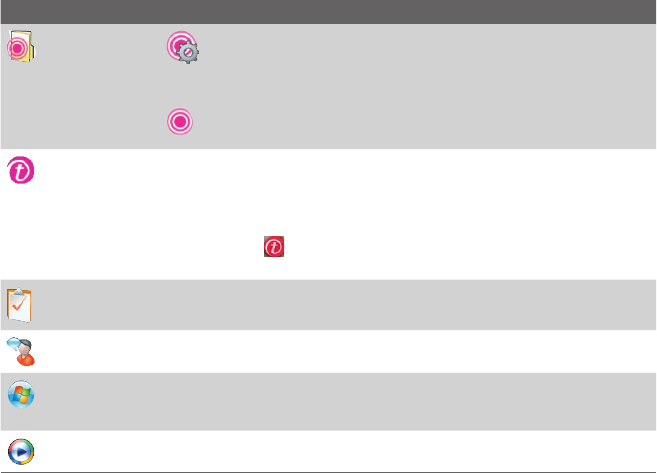
Getting Started 49
Icon Program Description
T-Mobile
HotSpot
HotSpot
Settings
Enter your HotSpot username and password to automatically
connect when you are in a T-Mobile HotSpot. You need to
have a T-Mobile HotSpot account to access the T-Mobile
HotSpot wireless network.
HotSpot
Status
See if you are in the T-Mobile HotSpot coverage area. Use this
program to log off from T-Mobile HotSpot.
t-zones Visit T-Mobile's t-zones Web site to purchase ring tones, wallpaper, or games to
personalize your phone. You can also manage your accounts and access other
helpful information.
You can quickly go to the t-zones page to purchase wallpapers or ringtones by
scrolling down to on the Shortcuts bar and selecting Browse Wallpaper or
Browse Hi-Fi Ringers.
Tasks Keep track of your tasks.
Voice
Command
Call contacts, open applications, play back music, and get calendar information just
by using your voice.
Windows
Live
Use this mobile version of Windows LiveTM to find information on the Web. It lets you
sign in to your Windows Live account so that you can access your Live Mail messages
and send/receive instant messages in Live Messenger.
Windows
Media Player
Play back video and audio files.
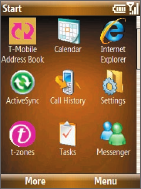
50 Getting Started
1.8 Using the Start Menu
The Start menu is located at the bottom-left corner of the
Home screen and displays various program icons that are
spread across one or more screens.
To see the available programs in the Start menu
On the Home screen, select Start. To see more programs,
select More or use the NAVIGATION WHEEL.
Start menu
1.9 Using the Quick List
The Quick List offers convenient access to a list of functions, such as locking your phone, opening
Comm Manager, and choosing a different profile. For more information about profiles,
see Chapter 4.
To access the Quick List
1. Press and hold the HOME button.
2. Scroll through the list and select the desired option. Then, do any of the following:
• Select Select.
• Press the corresponding number on the 20-key QWERTY keyboard.
• Press CENTER SELECT.
3. To exit the Quick List at any time, select Cancel.

Getting Started 51
1.10 Entering Information
You can enter text, numbers, and symbols by using the 20-key QWERTY keyboard. When you select
a field that requires entering text or numbers, the phone automatically selects the appropriate
input mode. The status indicator on the top-right side of the display screen shows the input mode
that you are currently using.
Input modes
Lowercase text input Numeric or symbol (labeled
in brown color) input
T9 text input mode, uppercase
Uppercase text input,
caps lock
Numeric or symbol (labeled
in blue color) input, locked T9 text input mode, caps lock
Uppercase text input T9 text input mode, lowercase
To change the input method, press and hold and select the input method you want to use on
the menu.
Note The menu only opens when text input is possible. Pressing and holding the key any other time will
lock the phone.
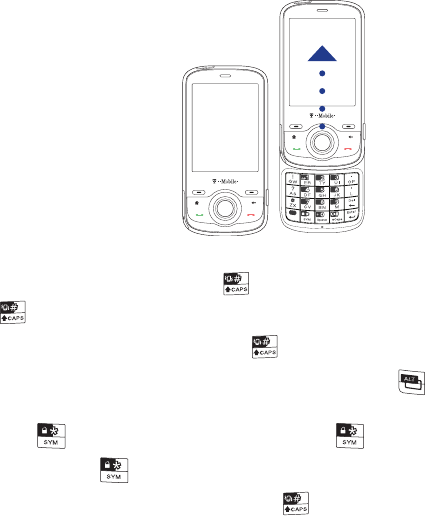
52 Getting Started
The 20-key QWERTY keyboard
To reveal the 20-key QWERTY keyboard, slide up the front panel of the phone.
Slide up the front panel
You can do the following with the 20-key QWERTY keyboard:
• To use all uppercase letters, press twice. To change back to all lowercase letters, press
again.
• To use a single uppercase letter, press and then press the corresponding key.
• To enter a number or symbol (labeled in brown color), press and then press the
corresponding key.
• Press to open the Symbol pad. Press and hold to open the input menu.
• Press and hold to lock the phone (when text input is not possible).
• While on the Home screen, press and hold to toggle between Ringer and Vibrate modes.
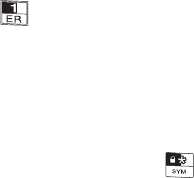
Getting Started 53
• Press and hold to access your voicemail. Your voicemail number must be set up for this
to work. To check, select Start > Settings > Phone > Call Options and then check Voice
mail number.
Multipress mode
In Multipress mode, you enter a character by pressing the key on which the character appears.
To switch to Multipress mode
1. While on a text field, press and hold the key.
2. On the menu, select ABC.
To enter text in Multipress mode
• To enter the first character on the numeric key, press once. To enter the second character on
the numeric key, press twice, and so on.
• To enter characters that are on the same key, wait for the line under the character to
disappear before you press the key again.
To change the Multipress time out
You can change the length of time to pause between keypresses on the same numeric key.
1. On the Home screen, select Start > Settings > More > Accessibility.
2. In Multipress time out, choose the length of the pause between keypresses and
select Done.

54 Getting Started
T9 mode
To form a word in T9 mode, press the keys that contain the letters you want. As you enter letters,
T9 analyzes your keypresses and attempts to complete the word. T9 also tries to predict your next
word based on previous sentences you have typed.
To switch to T9 mode
1. While on a text field, press and hold the key.
2. On the menu, select T9 English.
To add custom words to the T9 My Words list
Save words that you often use but are not in the English dictionary into the T9 My Words list.
Words that you add into the T9 My Words list will appear in the predicted word list.
1. While on a text field, press and hold the key.
2. On the menu, select T9 My Words > Add.
3. In the Add/Edit Word box, enter the word and select Done.
To edit or delete words in the T9 My Words list, select Menu and then select the appropriate
command in the menu.
To set T9 settings
Press and hold and on the menu, choose T9 Settings. In the screen, choose the options you
want and select Done.
• Select Spell Correction to correct typographical errors by selecting from a list of possible
words that reflect the characters of the keys you have pressed as well as characters of nearby
keys.
• Select Next Word Prediction to predict the next word in your text based on previous
phrases you have constructed. As you type more messages, the software learns your typing
behavior enabling it to predict the word that you will likely type next.
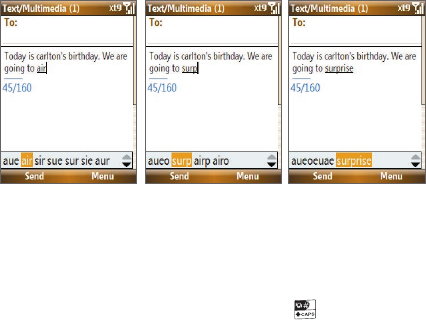
Getting Started 55
• Select Auto-Append to automatically add your constructed words that are not in the
dictionary to the beginning of the predicted word list.
• Select Auto-Substitution to automatically add an apostrophe when you type common
contracted words (e.g. dont automatically becomes don’t).
• Select Word Completion to let you select from a list of possible words based on the keys
that you pressed and on the words available in the dictionary.
• Select Multitap Word Completion to let you select from a list of possible combinations
based on the characters that appear on the keys that you pressed.
To type using T9 mode
While typing, words will appear at the bottom of the screen. Use the NAVIGATION WHEEL to
choose the word you want to insert and press CENTER SELECT.
For example, to type “surprise”, just spell out the word “surprise” using the keyboard. You will notice
that pressing the keys for the first 3 characters will spell out “air” but after you press the key for the
fourth character, the word changes to “surp.” Continue typing until you see the word “surprise” at
the bottom.
Tip To type in all uppercase letters, press the key twice.

56 Getting Started
Numeric mode
If a text box permits a numeric entry only, such as a phone number, the input mode automatically
defaults to Numeric mode. However, if you need to enter numbers within a line of text, change to
Numeric mode (123 on the menu).
To enter numbers in text boxes
Press and then press the numeric key.
Tip To lock the input mode to Numeric mode in a text box, press twice.
1.11 Battery Information
Battery performance depends on many factors, including T-Mobile’s network configuration, signal
strength, the temperature of the environment in which you operate your phone, the features and/
or settings you select and use, items attached to your phone’s connecting ports, and your voice,
data, and other program usage patterns.
Battery life estimates (approximations):
• Talk time: GSM/UMA: Up to 8 hours
• Standby time: GSM: Up to 340 hours
UMA: Up to 120 hours
• Playing WMV: Up to 8 hours
• Playing WMA: Up to 12 hours
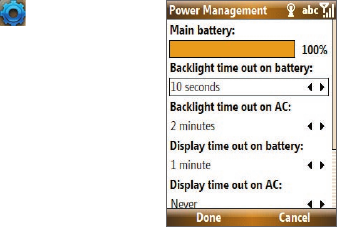
Getting Started 57
WARNING! To reduce risk of fire or burns:
• Do not attempt to open, disassemble, or service the battery pack.
• Do not crush, puncture, short external contacts, or dispose of in fire or water.
• Do not expose to temperatures above 140˚F.
• Replace only with the battery pack designated for this product.
• Recycle or dispose of used battery as stipulated by local regulation.
To check and optimize battery power
On the Home screen, scroll down to on the Shortcut
Bar, then select Manage Battery. On the Power
Management screen, adjust the backlight, display, and
light sensor settings.
To manage low battery
When the low-battery warning appears, do the following:
1. Immediately save your current data.
2. Synchronize with your PC or use the AC adapter to
charge the battery.
3. Turn off your phone. Turn it back on only when you
need to use it.

58 Getting Started
1.12 Shortcut Key
The SHORTCUT KEY on the right side of the phone can be configured to open 2 applications that
you set. By default, briefly pressing the SHORTCUT KEY calls up a message screen (afterwards, it
opens the Messaging program); pressing and holding the SHORTCUT KEY opens Voice Command.
To customize Shortcut Key settings
1. Select Start > Settings > Shortcut Key.
2. In Short press, select the application to open when you briefly press the SHORTCUT KEY.
3. In Press and hold, select the application to open when you press and hold the SHORTCUT
KEY.
4. Select Done.
1.13 Status Indicators
The following table lists common status indicators and their meanings.
Icon Description
T-Mobile HotSpot in use
T-Mobile HotSpot detected, user is not logged in
Wi-Fi is on, but phone not connected to a wireless network
Wi-Fi connected
Connecting to wireless network
Synchronizing via Wi-Fi
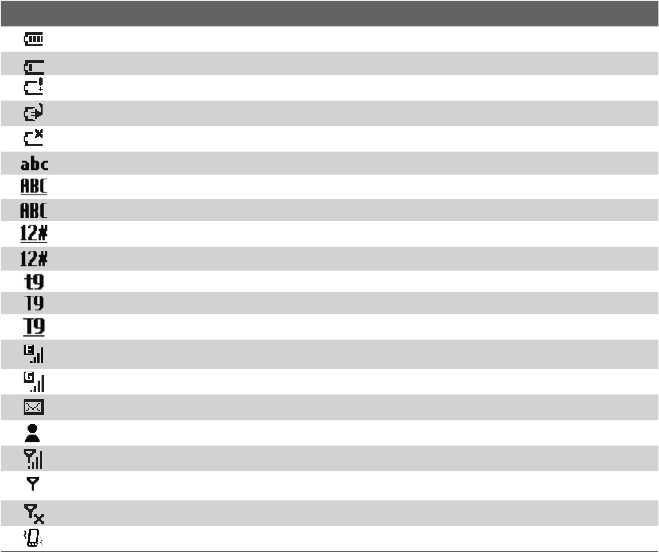
Getting Started 59
Icon Description
Battery level
Low battery
Very low battery
Battery charging
No battery or battery fault
Lowercase text input
Uppercase text input, caps lock
Uppercase text input
Numeric or symbol input (labeled in blue color), locked
Numeric or symbol input (labeled in brown color)
T9 text input mode, lowercase
T9 text input mode, uppercase
T9 text input mode, caps lock
EDGE in use
GPRS in use
New e-mail or text message
(SMS, Short Message Service)
New instant message from Live Messenger
Signal strength
Radio connected or no signal
Radio off
Vibrate call alert
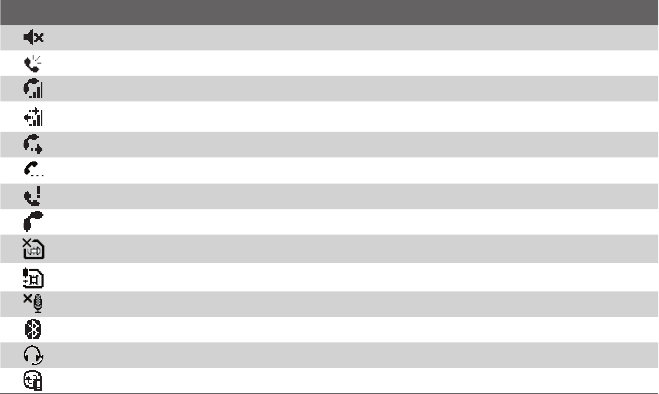
60 Getting Started
Icon Description
Ringer off
Speakerphone on
Voice call in progress
Data call in progress
Calls forwarded
Call on hold
Missed call
Dialing while no SIM card is inserted
No SIM card installed
SIM card with fault
Microphone muted
Bluetooth
Bluetooth headset connected
Sync error

Chapter 2
Using Phone Features
2.1 Using the Phone
2.2 Making a Call
2.3 Receiving a Call
2.4 In-Call Options
2.5 Additional Dialing Information

62 Using Phone Features
2.1 Using the Phone
You can use your phone to make, receive, and keep track of voice calls, and send text messages
(SMS, Short Message Service) and Multimedia Messages (MMS, Multimedia Messaging Service).
You can also dial a phone number directly from Contacts, and easily copy SIM contacts to Contacts
on the phone.
When connected to a Wi-Fi network, you can use Unlicensed Mobile Access (UMA) technology
to make and receive calls. UMA technology also lets you switch between the T-Mobile cellular
network and Wi-Fi network seamlessly when you are using your phone. To learn how to connect to
a Wi-Fi network, see Chapter 8. For more information about the UMA features of the phone, please
contact T-Mobile.
The Phone screen
From the Phone screen, you can open, call, or find a contact, and even save a new number in
Contacts. To access the Phone screen, do any of the following:
• Open the keyboard and directly enter the phone number by pressing numeric keys on the
keyboard.
• Press (only when myFaves is minimized or turned off).
Set ring tones
You can choose how to be notified for incoming calls, reminders, new messages, alarms, and more.
To set a ring tone for incoming calls
1. On the Home screen, scroll down to on the Shortcut Bar, then select Change Ringtone.
2. In the Ring tone list, select a ring tone.
3. Select Done.
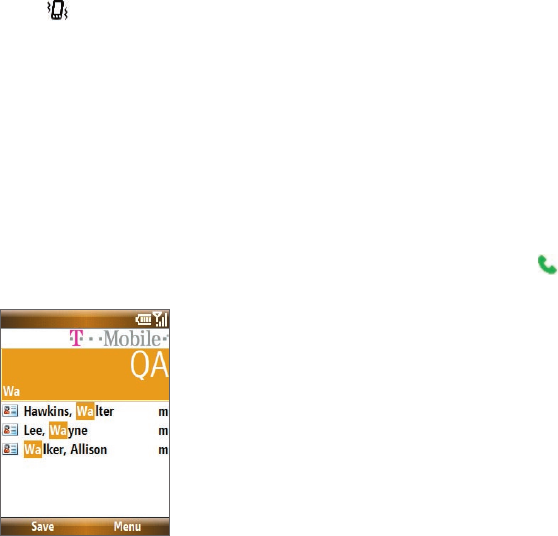
Using Phone Features 63
If you select Vibrate, the sound is muted and the phone will vibrate when you receive a call. The
Vibrate icon ( )
appears in the title bar. Selecting None in the Ring tone list mutes the phone. For
more information about sounds, see “Choose how to be notified about events or actions”
in Chapter 4.
Note To adjust the earpiece volume during a call, use the VOLUME BUTTONS on the side of the phone.
2.2 Making a Call
With your phone, you can make calls from the Home screen, the Phone screen, from Contacts,
Speed Dial, Call History, or SIM Contacts (contacts stored on your SIM card). You can choose to dial
by name or number.
Make a call from the Home screen
• Enter the phone number or name of the contact on the keyboard and then press .
• Press the BACK button or DEL key if you need to backspace.
Phone Screen

64 Using Phone Features
Tip You will notice that when you press a key on the keyboard, a list of names and numbers is displayed as
your phone searches Contacts, Call History, Speed Dial, and your SIM card to find a matching name or
number. For example, when you press a key such as 5, names that begin with G and H will be displayed
as well as phone numbers that start with 5. The next key you press continues to narrow the search.
When you see the name of the person you want to call, select it, and press .
Make a call from Contacts
1. On the Home screen, select Contacts.
2. Select the desired contact and then press .
You can also select the desired contact in the contact list, and press CENTER SELECT twice (once to
view the contact details, and once to dial the associated number).
To specify the number to dial
1. On the Home screen, select Start > Contacts.
2. Select the contact.
3. Press NAVIGATION WHEEL left or right. The letter representing the number changes to m
(mobile), w (work), or h (home).
You can also select a contact in the contact list and press CENTER SELECT to view details and
different numbers associated with the contact. Select a number and press or press CENTER
SELECT to dial the number.
• You may also access the contact list by selecting Contacts on the Home Screen.
• To view or edit information associated with the selected contact, select Menu > Edit.
• To save a contact on your SIM card, select Menu > Save to SIM.
Make a call from Call History
1. On the Home screen, select Start > Call History.
2. Select a name or number and then press .
Using Phone Features 65
In the Call History screen, you can view the call history details of a contact such as date, time of call,
and the length of the call by pressing CENTER SELECT. Pressing CENTER SELECT again dials the
associated number.
To customize calls
You can select various options on the Call History screen to customize and filter the calls made,
received, or missed.
• To find a name or number in Contacts, select Menu > Find Contact.
• To send a text message, select Menu > Send Text Message.
• To send an e-mail, select Menu > E-mail.
• To find the duration of a call, select Menu > View Timers.
• To remove a call or number from Call History, select Menu > Delete.
• To remove the list of calls or numbers from Call History, select Menu > Delete List.
• To save a name or number in Contacts, select Menu > Save to Contacts.
• To categorize the call or number into various call types, select Menu > Filter.
Note You can also save a number in Contacts by selecting Save on the Call History screen.
Make a call from Speed Dial
You can make calls using Speed Dial. To learn how to use Speed Dial, see Chapter 10.
Make a call from SIM Manager
1. Select Start > Accessories > SIM Manager. Wait for the contents of your SIM card to load.
2. Choose the contact you want to call and select Menu > Dial.

66 Using Phone Features
2.3 Receiving a Call
When you receive a phone call, you have the option to answer, ignore, or reject it. You can also use
the VOLUME BUTTONS to lower the ringer volume.
To answer, ignore or reject an incoming call
•
To answer the call, open the keyboard.
•
To answer the call, select Answer or press .
• To ignore or reject the call, select Ignore or press
.
To end a call
• If the keyboard is opened, close the keyboard.
• Press
.
You can set answering and ending call options by selecting Start > Settings > Slide and Key Lock.
Choose the options you want in Answer mode and Hang up mode.
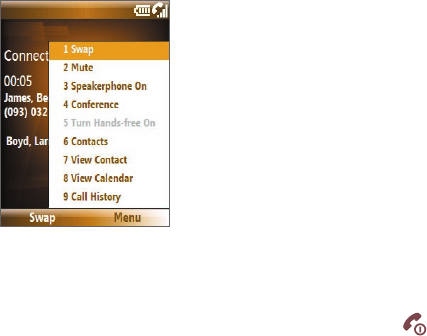
Using Phone Features 67
2.4 In-Call Options
Your phone provides various options for managing multiple calls at the same time. You are notified
when you have another incoming call, and you have the choice of ignoring or accepting the call. If
you are already on a call and accept the new call, you can choose to switch between the two callers,
or set up a conference call between all three parties.
In-Call Options
To answer another call
1. Select Answer to take the second call and put the first call on hold.
2. To end the second call and return to the first call, press
.
To switch between calls
To switch between two calls, select Swap.
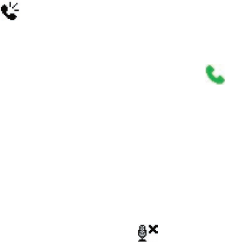
68 Using Phone Features
To set up a conference call
1. Either put a call on hold and dial a second number, or, answer a second incoming call during
a call.
2. Select Menu > Conference.
Notes
• If the conference connection is successful, the word “Conference” appears at the top of the screen.
• To add additional persons to your conference call, select Menu > Hold, enter the phone number, and then
select Resume to return to the call.
To turn on and off the Speakerphone
The built-in Speakerphone lets you talk hands-free or lets other people listen to the conversation.
• During a call, select Menu > Speakerphone On. The icon appears at the top of the
screen.
• To turn off the Speakerphone during the call, select Menu > Speakerphone Off.
Alternatively, the Speakerphone can be toggled on and off by pressing and holding
during the call.
Note It is not recommended to hold your phone against your ear when the Speakerphone is turned on as
this might damage your hearing.
To mute a call
You can turn off the microphone during a call, so that you can hear the caller but the caller cannot
hear you.
Press the left SOFT KEY to select Mute. When the microphone is turned off, the icon appears
on the screen. Press the left SOFT KEY to select Unmute to turn on the microphone again.

Using Phone Features 69
2.5 Additional Dialing Information
Make an emergency call
Dial the emergency number (911) and then press .
Make an international call
1. Press and hold the key on the keyboard until appears.
2. Enter the full phone number and then press .
For example: +(1)(909)(22222222) (country code) + (area code) + (phone number).
Insert a pause or long pause in a dialing sequence
Some international calls or phone numbers require a pause or long pause in the dialing sequence
for the call to process successfully.
1. On the Home screen, select Start > Contacts.
2. Select the contact and press CENTER SELECT to open the contact card.
3. Select Menu > Edit.
4. Position the cursor on the phone number where you want to insert a pause.
5. Select Menu > Insert Pause or Insert Wait.
The letter “p” (Insert Pause) or “w” (Insert Wait) will appear in the number sequence to
indicate where the pause or long pause will occur.
Note Long pause is not available for contacts stored on the SIM card.
6. Select Done.
Note When you call a number that contains a long pause, you must press again to continue dialing.
70 Using Phone Features

Chapter 3
Synchronizing Information with
Your Computer
3.1 About Synchronization
3.2 Setting Up Windows Mobile® Device Center on Windows Vista
3.3 Setting Up ActiveSync® on Windows XP
3.4 Synchronizing With Your Computer
3.5 Synchronizing via Bluetooth
3.6 Synchronizing Music and Video
72 Synchronizing Information with Your Computer
3.1 About Synchronization
You can take information from your computer wherever you go by synchronizing them to your
phone. The following types of information can be synchronized:
• Microsoft® Outlook® information, which includes Outlook e-mail, contacts, calendar, and
tasks
• Media, such as pictures, music and video
• Favorites, which are the bookmarked links to your favorite Web sites
• Files, such as documents and other files
Note You need to use Windows Media Player to synchronize songs that are DRM-protected.
Before you can synchronize, you need to first install the synchronization software to your
computer. For information on installing and using the synchronization software on your computer,
see “Setting Up Windows Mobile® Device Center on Windows Vista” and “Setting Up ActiveSync® on
Windows XP” in this chapter.
Ways to synchronize
After you have installed the synchronization software to your computer, synchronize your phone
with your computer by using one of the following:
• Connect and synchronize using the supplied USB sync cable.
Upon connecting the sync cable to your phone and your computer, the synchronization
process starts automatically.
• Connect and synchronize using Bluetooth.
You must first set up a Bluetooth partnership between your phone and your computer
before you can synchronize information between them using Bluetooth. For more
information about setting up a Bluetooth partnership, see Chapter 8. For information about
synchronizing through Bluetooth, see “Synchronizing via Bluetooth” later in this chapter.
Synchronizing Information with Your Computer 73
Note You can also synchronize Outlook e-mail, contacts, calendar, and tasks on your phone with the
Exchange Server at your work. For more information about setting up your phone to synchronize with
the Exchange Server, see Chapter 7.
3.2 Setting Up Windows Mobile® Device Center on Windows Vista
Microsoft Windows Mobile® Device Center is the replacement for Microsoft® ActiveSync® on
Windows Vista®.
Note Some versions of Windows Vista come with Windows Mobile® Device Center already installed. If
Windows Mobile® Device Center is not available on your Windows Vista, you can install it from the
Getting Started Disc that came with your phone.
Set up synchronization in Windows Mobile® Device Center
1. Connect your phone to your PC. Windows Mobile® Device Center configures itself and then
opens.
2. On the license agreement screen, click Accept.
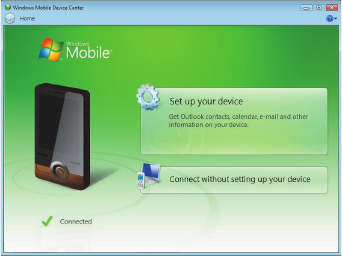
74 Synchronizing Information with Your Computer
3. On the Windows Mobile® Device Center’s Home screen, click Set up your device.
Note Choose Connect without setting up your device if you only want to transfer media files, check
for updates, and explore your phone but not sync Outlook information.
4. Select the items that you want to synchronize and then click Next.
5. Enter a device name for your phone and then click Set Up.
When you finish the wizard, Windows Mobile® Device Center synchronizes your phone
automatically. Notice that Outlook e-mails and other information will appear on your phone after
synchronization.
Synchronizing Information with Your Computer 75
3.3 Setting Up ActiveSync® on Windows XP
The Getting Started Disc that comes with your phone contains Microsoft® ActiveSync® 4.5 or later.
Follow the steps below to install and set up ActiveSync® on Windows XP or other compatible
Windows systems.
Notes
• You can also download ActiveSync 4.5 from the Microsoft ActiveSync® Web site:
http://www.microsoft.com/windowsmobile/activesync/default.mspx
• From the above Web site, you will find the system requirements for ActiveSync 4.5.
Install ActiveSync®
1. Insert the Getting Started Disc into the disc drive on your PC.
2. Click Setup and Installation.
3. Select the ActiveSync check box and click Install.
4. Read the license terms and click Accept.
5. When installation is complete, click Done.
6. On the Getting Started with Windows Mobile screen, click Close.
Set up synchronization in ActiveSync®
Follow the steps below to set up a synchronization partnership.
1. Connect your phone to your PC. The Synchronization Setup Wizard automatically starts and
guides you to create a synchronization relationship. Click Next to proceed.
2. To synchronize your phone with your computer, clear the Synchronize directly with a
server running Microsoft Exchange Server check box and then click Next.
3. Select the items that you want to synchronize and then click Next.

76 Synchronizing Information with Your Computer
4. Select or clear the Allow wireless data connections check box according to your
preference.
5. Click Finish.
When you finish the wizard, ActiveSync synchronizes your phone automatically. Notice that
Outlook e-mails and other information will appear on your phone after synchronization.
3.4 Synchronizing With Your Computer
Connect your phone to your PC to synchronize the information between your phone and PC. While
your phone is connected, Windows Mobile® Device Center or ActiveSync® on your PC automatically
synchronizes when you make a change on either the PC or your phone.
Start and stop synchronization
You can also manually start and stop synchronization either from your phone or PC.
From your phone
1. After connecting your phone to your PC, select Start > ActiveSync on your phone.
2. Select Sync to start synchronization.
To end synchronization before it completes, select Stop.
Note To delete a partnership with one PC completely, select Menu > Options, select the computer name,
then select Menu > Delete.
From Windows Mobile® Device Center
1. Click Start > All Programs > Windows Mobile Device Center.
2. Click at the lower left of the Windows Mobile® Device Center.
To end synchronization before it completes, click .

Synchronizing Information with Your Computer 77
From ActiveSync on your PC
• To manually start synchronization, open ActiveSync on your PC and click .
• To end synchronization before it completes, click .
Change which information is synchronized
You can add or reduce the types of information to synchronize between your phone and PC.
1. Before changing synchronization settings on your phone, disconnect your phone from your
PC.
2. On your phone, select Start > ActiveSync.
3. Select Menu > Options.
4. Select or clear the items you want to synchronize or not synchronize. If you cannot select a
check box, you might have to clear the check box for the same information type elsewhere in
the list.
5. To customize settings for an item, select that item and select Settings. Settings are not
available for all items.
Notes
• The check boxes of the Favorites, Files, Media, and OneNote items are always grayed out in ActiveSync
Options on your phone. You can only select or clear these items from Windows Mobile Device Center or
ActiveSync on your computer.
• A PC can have sync partnerships with many different Windows Mobile® powered devices, but a device can
have sync partnerships with at most two PCs only. To ensure that your phone will synchronize properly
with both PCs, set up the second PC using the same synchronization settings you used on the first PC.
• Outlook e-mail can be synchronized with only one computer.
78 Synchronizing Information with Your Computer
Troubleshoot sync connection problems
When the PC is connected to the Internet or a local network, in some cases, the PC may disconnect
the ActiveSync® connection with your phone in favor of the Internet or network connection. If
this happens, select Start > Settings > Connections > More > USB to PC, then clear the Enable
advanced network functionality check box. This makes ActiveSync use a serial USB connection
with your phone.
3.5 Synchronizing via Bluetooth
You can connect and synchronize your phone with the PC using Bluetooth.
To synchronize with a computer via Bluetooth
1. Set up the synchronization software (Windows Mobile® Device Center or ActiveSync) on your
computer to use a Bluetooth connection. For more information, see the software Help on
your computer.
2. On your phone, select Start > ActiveSync.
3. Make sure that Bluetooth on both your phone and the computer are turned on and set to
Visible mode. For more information, see “Bluetooth” in Chapter 8.
4. Select Menu > Connect via Bluetooth.
5. If this is the first time you have connected to this computer via Bluetooth, you must first
complete the Bluetooth wizard on your phone and set up a Bluetooth partnership between
your phone and the computer. For more information about creating a Bluetooth partnership,
see “Bluetooth partnerships” in Chapter 8.
Notes
• To preserve battery power, turn off Bluetooth when not in use.
• To connect and synchronize your phone with a computer via Bluetooth, your computer must have built-in
Bluetooth or be installed with a Bluetooth adapter or dongle.
Synchronizing Information with Your Computer 79
3.6 Synchronizing Music and Video
If you want to carry your music or other digital media along with you while you travel, set up
Microsoft® Windows Media® Player on your computer to synchronize music and video with your
phone.
Other than selecting the Media information type in ActiveSync® for synchronization, all media
synchronization settings must be set in Windows Media® Player. Before you can synchronize media,
you must do the following:
• Install Windows Media® Player 11 on the PC. (Windows Media® Player 11 works only in
Windows XP or later versions.)
• Connect your phone to the PC with a USB cable.
• Set up a sync partnership between the phone and your PC’s Windows Media® Player.
Note Use Windows Media® Player 11 to properly transfer digitally protected music files from your computer
to your phone. If you do not use Windows Media® Player 11 to synchronize the files, you will not be able
to play them on your phone.
For more information about using Windows Media® Player on your phone, see “Windows Media®
Player Mobile” in Chapter 9.
80 Synchronizing Information with Your Computer

Chapter 4
Managing your Phone
4.1 Personalizing Your Phone
4.2 Adding and Removing Programs
4.3 Using Task Manager and Managing Memory
4.4 Managing and Backing Up Files
4.5 Protecting Your Phone
4.6 Restarting Your Phone
4.7 Resetting Your Phone

82 Managing your Phone
4.1 Personalizing Your Phone
Set up the Home screen
The Home screen is your starting place for most tasks. You can gain access to all features and
programs from the Home screen.
To customize the Home screen
1. On the Home screen, select Start > Settings > Home Screen.
2. In Home screen layout, Color scheme, Background image, and Time out, choose the
options you want, and select Done.
Tip If you only want to change the background image, you can do it from the Shortcut Bar. On the Home
screen, scroll down to on the Shortcut Bar, and then select Change Wallpaper.
To set a picture as the background
1. On the Home screen, select Start > Pictures & Videos.
2. Select the picture you want to set as the background. Select View or press CENTER SELECT
for a larger view of the image.
3. Select Menu > Use as Home Screen.
4. Use the NAVIGATION WHEEL to select the portion of the picture you want to use, and select
Next. If the picture fits the screen, this step is skipped.
5. In Adjust the transparency, select a higher percentage for a more transparent picture and
then select Finish.

Managing your Phone 83
Set date, time, language, and other regional options
Your phone should already be set up with the regional settings that are appropriate for your locale.
To change regional settings
You can specify the language, locale, date and time style, as well as number and currency
formatting options.
1. On the Home screen, select Start > Settings > More > Regional Settings.
2. In Language, select your preferred language.
3. In Locale, select the locale for the language you selected. The Locale option automatically
changes the format of the remaining options (such as date, time, and currency) according to
the locale you specify.
4. Select Done.
To set the date and time
1. On the Home screen, select Start > Settings > Clock & Alarm > Date and Time.
2. Set the Time zone, Date, and Time, and then select Done.
Choose how to be notified about events or actions
A profile is a group of settings that determine how your phone will alert you to phone events such
as incoming calls and notifications.
To change the current profile
Profiles are preset phone sound settings to suit different environments or scenarios. For example,
you may want to set the phone to Vibrate or Silent profile when you are in a meeting.
1. On the Home screen, scroll down to on the Shortcut Bar and then select Change Profile.
2. Choose a new profile, and select Done.
Tip To quickly change the profile, press and hold the HOME key to display the Quick List, and choose a
profile.

84 Managing your Phone
To edit a profile
1. On the Home screen, scroll down to on the Shortcut Bar and then select Change Profile.
2. Select the profile to edit.
3. Select Menu > Edit.
4. Modify the settings, and select Done. To cancel without saving changes, select Cancel.
Tip To revert to the default profile settings, select Menu > Reset to default.
To change the ringtone
1. On the Home screen, scroll down to on the Shortcut Bar and then select Change
Ringtone.
2. For the desired event, select a sound. Select None if you do not want to hear a sound.
3. Select Done.
Notes
• For ring tones, you can use sound files in either the .wav, .mid, .wma, or .mp3 file format. For notifications
or reminders, you can use .wav or .mid files.
• Music files in the My Music folder cannot be used as ringtones.
Tip When you select a sound, the sound plays. To hear it again, select Menu > Play.
To copy a sound to your phone
After a sound file is located on your phone, you can use it for a ring tone, notification, or reminder.
Sound files in either .wav, .mid, .wma, or .mp3 formats can be used.
1. Connect the phone to your PC using a USB connection.
2. On your PC, copy the sound file you want.
Managing your Phone 85
3. In Windows Mobile® Device Center, click File Management > Browse the contents of your
device.
Or
In ActiveSync® on your PC, click Explore and double-click My Windows Mobile-Based
Device.
4. Save the sound file on your phone by going to Application Data > Sounds, and pasting the
file into that folder.
To set an alarm
1. On the Home screen, select Start > Settings > Clock & Alarm > Alarm.
2. In Alarm time, enter the time for the alarm to go off.
3. In Alarm, choose when you want the alarm to go off.
4. Select Done.
Set personal information
Entering and displaying owner information are best practices; they allow someone to return the
phone to you in case it is lost.
To enter owner information
1. On the Home screen, select Start > Settings > More > Owner Information.
2. Enter the necessary information and then select Done.

86 Managing your Phone
Set performance and maintenance options
To change accessibility settings
1. On the Home screen, select Start > Settings > More > Accessibility.
2. Select your preference for the following:
• In System font size, set the size of the font that is displayed on the screen.
• In Multipress time out, set the length of time between keypresses when entering text in
Multipress mode.
• In Confirmation time out, set the delay before an unconfirmed action times out.
• In In-call alert volume, set the volume for incoming call or receiving new message alerts
while you are in a call.
3. Select Done.
To change power management settings
You can use Power Management to check the battery and configure settings that prolong battery
life.
1. On the Home screen, scroll down to on the Shortcut Bar, then select Manage Battery.
2. Adjust the following settings:
• In Backlight time out on battery / AC, select the amount of time for the phone to be idle
before the backlight turns off when using the battery or AC power.
• In Display time out on battery / AC, select the time limit for the phone to be idle before
the screen turns off when using the battery or AC power.
• In When device is turned on, do not charge the battery when connected to PC,
select On if you do not want to charge the battery when the device is connected to the
computer.
3. Select Done.
Managing your Phone 87
Tip Main battery indicates the amount of battery life remaining.
To find the operating system version number
On the Home screen, select Start > Settings > About.
To find the phone specification
On the Home screen, select Start > Settings > System Information.
4.2 Adding and Removing Programs
Before you purchase additional programs for your phone, make sure that they are compatible with
your phone.
To add programs
1. Download the program to your PC (or insert the disc that contains the program into your
PC). You may see a single *.exe file, a *.zip file, a Setup.exe file, or several versions of files for
different device types and processors. Be sure to select a program designed for your phone
and processor type.
2. Read the installation instructions that come with the program.
3. Connect your phone to the PC and then double-click the *.exe file.
To remove a program
1. On the Home screen, select Start > Settings > More > Remove Programs.
2. Scroll to the program to remove and then select Menu > Remove.
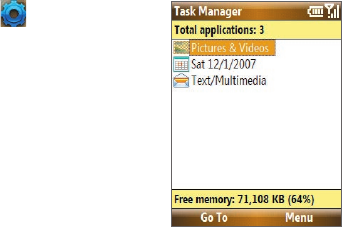
88 Managing your Phone
4.3 Using Task Manager and Managing Memory
To check how much memory is available
1. On the Home screen, select Start > Settings > More > About.
2. Scroll down to Available Memory.
To close running programs in Task Manager
Task Manager lets you close programs currently running on your phone to free up storage space.
1. On the Home screen, scroll down to on the Shortcut
Bar, then select Improve Performance.
2. Choose a program on the list and select Menu > Stop.
On the Task Manager screen, select Menu to open a list that lets
you go to a specific program, stop running programs, and view
system information.
4.4 Managing and Backing Up Files
You can back up files to your PC using Windows Mobile® Device Center or ActiveSync® or copy files
to a storage card that is installed on your phone. You can also efficiently manage your files and
folders using File Explorer installed on your phone.
Managing your Phone 89
Copy files using Windows Mobile® Device Center/ActiveSync® to the PC
1. Connect your phone to your PC.
2. In Windows Mobile Device Center, click File Management > Browse the contents of your
device.
Or
In ActiveSync on your PC, click Explore. This opens the Mobile Device folder for your phone.
3. Browse your phone for files that you want to copy to your PC.
4. Select and copy the files [Ctrl + C] and then paste them [Ctrl+V] to the destination folder in
the PC.
Copying a file results in separate versions of a file on your phone and PC. Changes made to one file
will not affect the other since the files are not synchronized.
Use File Explorer
File Explorer provides many easy-to-use features for file and folder management.
To start File Explorer
On the Home screen, select Start > File Explorer.
File Explorer operates in the following two views:
• List View
• Icons View
File Explorer displays the entire file structure in your phone’s memory. The functions focus primarily
on folder management. When initially started, File Explorer is in List View by default. To switch
between views, select Menu > View > Icons or List.
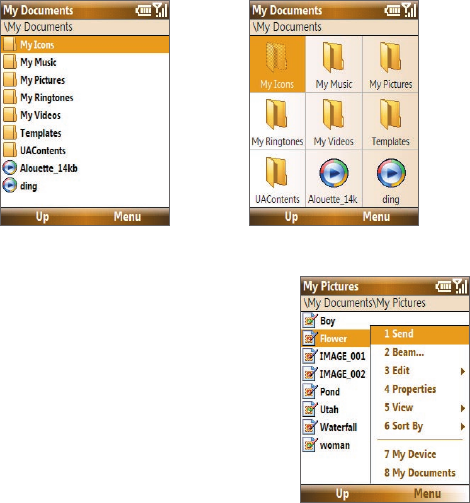
90 Managing your Phone
File Explorer - List View File Explorer - Icons View
In File Explorer, select Menu to open a
list that lets you send or beam the file,
view the file’s properties, sort the files,
and more.
Managing your Phone 91
To send a file as an e-mail attachment
1. In File Explorer, select a file and select Menu > Send.
2. On the Messaging screen, select an e-mail account. The file will automatically be attached to
the new message.
3. Specify the recipient and subject, and type your message.
4. Select Send.
Note You can also send the file using Picture Message.
4.5 Protecting Your Phone
You can protect your phone from unauthorized use by requiring a PIN (personal identification
number) to make calls. Your default PIN is 1234. Additionally, you can also lock the entire phone.
To enable the SIM PIN
1. On the Home screen, select Start > Settings > Security > Enable SIM PIN.
2. Enter the PIN and then select Done.
Note To cancel without enabling the SIM PIN, press HOME.
To disable the SIM PIN
1. On the Home screen, select Start > Settings > Security > Disable SIM PIN.
2. Enter the PIN and then select Done.

92 Managing your Phone
To change the SIM PIN
Be sure to write down your PIN. When the SIM PIN is enabled, you must provide this PIN to unlock
the phone.
1. Select Start > Settings > Security > Change SIM PIN.
2. In Old PIN, enter the current PIN.
3. Enter and confirm the new PIN, and then select Done.
To lock the phone
Locking the phone turns off its functionality. This is a helpful feature if, for example, the phone is
turned on and in your pocket, and you want to prevent accidental keypresses. Once the phone is
locked, the left SOFT KEY label changes to Unlock.
You can lock the phone by:
• Pressing and holding for about 2 seconds (must not be in a text box).
• Pressing and holding the HOME key to open the Quick list and then selecting Lock.
• If the Manual Lock option is enabled in Settings, you will be prompted to lock the phone
when you close the keyboard.
Note You can still receive calls and make emergency calls when the phone is locked.
To automatically enable password protected phone lock
1. On the Home screen, select Start > Settings > Security > Device lock.
2. Select Prompt if device unused for and then select the amount of time for the phone to be
inactive before automatically locking.
3. Select the Password type, then enter and confirm your password.
4. Select Done.
Managing your Phone 93
To unlock the phone
Depending on whether the keyboard is opened or closed, you can unlock the phone by:
• Selecting Unlock and pressing the HOME key.
• Opening the keyboard if it is closed.
Note If a password has been enabled, you will be prompted for the password when you unlock the phone.
To disable the phone lock
Select Unlock and then enter the password you have set to unlock your phone.
To set keyboard lock options
1. Select Start > Settings > Slide and Key Lock.
2. Choose to enable or disable Auto lock timeout and/or Manual lock.
• Enabling Auto lock timeout locks the phone the same time the backlight goes off, if set
in Power Management, when the keyboard is closed.
• Enabling Manual lock prompts a message if you want to lock the phone or not when you
close the keyboard.
To encrypt files on the microSD card
Select Start > Settings > Security > Encryption and choose Encrypt files placed on storage
cards.
94 Managing your Phone
4.6 Restarting Your Phone
Restart your phone when a program is not performing properly or the phone is not responding to
any keypresses.
To restart the phone
1. Remove the battery.
2. Wait 3 seconds, then reinsert the battery and turn on your phone.
WARNING! Any unsaved work will be lost if you restart the phone while a program is running.
4.7 Resetting Your Phone
Resetting your phone will remove all the data from its memory and restore the phone back to the
factory default settings.
WARNING! All your data will be deleted, it is recommended that you back up your data first before resetting
your phone.
To reset your phone
1. Select Start > Accessories > Clear Storage.
2. Follow the on-screen instructions to reset the phone.
The phone will restart after it has been reset.
Note If Encrypt files placed on storage cards is or was enabled before, then back up all files from the
storage card before using Clear Storage, hard reset, or updating the ROM system software. Otherwise
you will no longer be able to access the encrypted files on the storage card. Use ActiveSync® or
Windows Mobile® Device Center to transfer files between your storage card and computer. After the
procedure, copy your files back to the storage card.

Chapter 5
Organizing Phone Information
5.1 Contacts
5.2 SIM Manager
5.3 T-Mobile® myFavesSM
5.4 Calendar
5.5 Tasks
5.6 T-Mobile Address Book
5.7 Voice Recorder
96 Managing your Phone
5.1 Contacts
Contacts is your address book and information storage for the people and businesses you
communicate with.
If you use Outlook on your PC, you can synchronize contacts between your phone and PC.
Create a contact on your phone
To create a new contact on your phone
1. On the Home screen, Start > Contacts > New > Outlook Contact.
To create a new contact on your SIM card, select SIM Contact. You can also use SIM Manager
to add contacts to your SIM card. For more information about SIM Manager, see “SIM
Manager” in this chapter.
2. Enter information for the new contact.
• To easily identify who is calling you, you can assign a custom ring tone to each Outlook
contact. To assign a custom ring tone, scroll down to and select Custom ring tone, and
then select the ring tone.
• To assign a picture to a contact, scroll down to Picture, select Select a picture, and then
choose the desired picture. To remove the picture, select Menu > Remove Picture.
3. Select Done.
Tip If someone who is not in your list of contacts calls you or sends you a message, you can quickly create a
contact from Call History or from the message by selecting Menu > Save to Contacts.

Managing your Phone 97
Edit and call a contact
To view and edit a contact information
1. On the Home screen, select Start > Contacts.
2. Select the contact whose information you want to view or edit and select Menu > Edit.
3. When finished making changes, select Done.
To call a contact from the contact list
1. On the Home screen, select Start > Contacts.
2. Select the contact to call and then press . The contact’s default phone number is dialed.
Tip To call a phone number other than the default, select the contact, scroll to the number you want to dial,
and then press .
Find a contact
To find a contact
1. On the Home screen, select Start > Contacts.
Note If you are not in Name view, select Menu > View By > Name.
2. Do one of the following:
• Begin entering a name or phone number of the contact until the contact is displayed.
When you press a key, such as 5, you find names that begin with G and H, as well as
phone numbers that start with 5. The next key you press continues to narrow the search.
• If you have assigned categories (e.g. Business) to your Outlook contacts, you can filter
the contact list by categories. In the contact list, select Menu > Filter and then select a
category. To show all contacts again, select All Contacts.
• If you have entered information under Company for your Outlook contacts, you can
quickly locate the contacts that work for a specific company on your phone. In the
contact list, select Menu > View By > Company. Select the company to see the contacts
who work there.
98 Managing your Phone
Share contact information
To beam contact information to another device via Bluetooth
1. On the Home screen, select Start > Contacts and then select the contact whose information
you want to beam.
2. Select Menu > Send Contact > Beam.
3. Select the device where you want to beam the contact details to and select Beam.
Note Before you can beam, make sure Bluetooth is turned on and set to Visible mode on your phone and
the target mobile device. For more information, see “Bluetooth” in Chapter 8.
To send contact information via a text message
1. On the Home screen, select Start > Contacts and then select the contact whose information
you want to send.
2. Select Menu > Send Contact > Text/Multimedia.
3. Select the contact information that you want to send and select Done.
4. In the new text message, enter the mobile phone number of the person to whom you are
sending the contact information to and then select Send.
To send contact information via Picture Message
1. On the Home screen, select Start > Contacts.
2. Select a contact and then select Menu > Send as vCard.
3. Enter the recipient in To of the Picture Message and then select Send.
Managing your Phone 99
5.2 SIM Manager
SIM Manager lets you view the contents of your SIM card and transfer contacts from your SIM card
to your phone and vice versa.
To create a contact on your SIM card
1. Select Start > Accessories > SIM Manager.
2. Select New and enter the contact name and phone number.
3. Select Save.
Tip To change contact information on your SIM card, select a contact and edit it. After modifying, select
Save.
To copy SIM contacts to your phone
1. Select Start > Accessories > SIM Manager.
2. Select a SIM contact or select all SIM contacts by selecting Menu > Select All.
3. Select Menu > Save to Contacts.
To copy phone contacts to the SIM card
You can only store one phone number on a SIM card for each contact. When you copy a contact
that has several phone numbers to your SIM card, SIM Manager saves each number under a
separate name.
To save each number under a different contact name on the SIM card, SIM Manager appends an
indicator at the end of each name. You can edit this indicator first before you start copying contacts
to your SIM card.
1. Select Start > Accessories > SIM Manager > Menu > Tools > Options.
2. On the Options screen, select the check boxes of the types of phone numbers that you want
to be added to the SIM card.
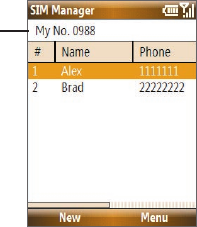
100 Managing your Phone
3. Under the Mark column, you can change the indicator that will be appended to the SIM
contact names for each phone number type. To do so, select a phone type, select Edit, enter
your desired indicator and then select Save.
4. After modifying, select OK.
5. Select Menu > Contacts to SIM.
6. Select the check boxes of the contact’s phone numbers that you want to copy to your SIM
card and then select Save.
To display your phone number in SIM Manager
1. On the SIM Manager screen, select Menu > Tools > List of Own Numbers.
2. Select Edit.
3. Change the name, if desired, then enter your mobile phone number.
4. Select Save.
When your phone number is stored
on the SIM card, it will appear on
the SIM Manager screen.